Monthly Archives:
CARSON WENTZ /25 BGS 9 ROOKIE Notable AUTO Inscribed RC SP 2016 PANINI ENCASED



Nice Condition, Clean and. From a Pet and Smoke Free Home! Please use the photos to judge item condition for yourself. All items may have some creases, marks, scratches, smears and/or and dust on them from. We strive to be reasonable in the event of a disagreement and ask that buyers afford us the same level of fairness. This item is in the category “Sports Mem, Cards & Fan Shop\Sports Trading Cards\Trading Card Singles”. The seller is “collectorsmantle” and is located in this country: US. This item can be shipped to United States, Canada, United Kingdom, Denmark, Romania, Slovakia, Bulgaria, Czech Republic, Finland, Hungary, Latvia, Lithuania, Malta, Estonia, Australia, Greece, Portugal, Cyprus, Slovenia, Japan, China, Sweden, Korea, South, Indonesia, Taiwan, South Africa, Thailand, Belgium, France, Hong Kong, Ireland, Netherlands, Poland, Spain, Italy, Germany, Austria, Bahamas, Israel, Mexico, New Zealand, Philippines, Singapore, Switzerland, Norway, Saudi Arabia, United Arab Emirates, Qatar, Kuwait, Bahrain, Croatia, Republic of, Malaysia, Brazil, Chile, Colombia, Costa Rica, Dominican Republic, Panama, Trinidad and Tobago, Guatemala, El Salvador, Honduras, Jamaica, Antigua and Barbuda, Aruba, Belize, Dominica, Grenada, Saint Kitts-Nevis, Saint Lucia, Montserrat, Turks and Caicos Islands, Barbados, Bangladesh, Bermuda, Brunei Darussalam, Bolivia, Ecuador, Egypt, French Guiana, Guernsey, Gibraltar, Guadeloupe, Iceland, Jersey, Jordan, Cambodia, Cayman Islands, Liechtenstein, Sri Lanka, Luxembourg, Monaco, Macau, Martinique, Maldives, Nicaragua, Oman, Peru, Pakistan, Paraguay, Reunion, Vietnam, Uruguay.
- Set: 2016 Panini Encased
- Card Number: RNI-CW
- Season: 2016
- Graded: Yes
- Player/Athlete: Carson Wentz
- Grade: 9
- Type: Sports Trading Card
- Features: Rookie
- Manufacturer: Panini
- Professional Grader: Beckett Grading Services (BGS)
- Sport: Football
- Original/Licensed Reprint: ORIGINAL
- Team: Philadelphia Eagles
- League: National Football League (NFL)
- Autographed: Yes

Argentina Author Legend Signed Ocampo Original Famous Vintage Autograph
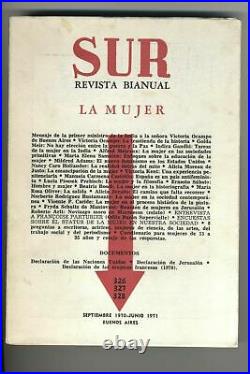
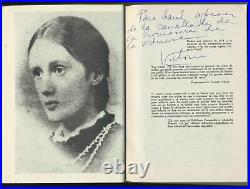
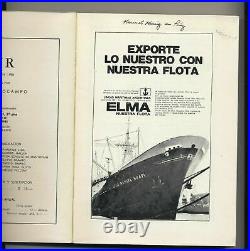

Sur Revista Bianual La Mujer [Nos 326, 327, 328]. By Ocampo, Victoria Ed. Book condition: Near Fine. Buenos Aires: Imprenta De Los Buenos Aires. Name on endpaper; ; Inscribed by Ocampo; 8vo. Title: Sur Revista Bianual La Mujer [Nos 326, 327, 328]. Author: Ocampo, Victoria Ed. Imprenta De Los Buenos Aires. Victoria Ocampo CBE was an Argentine writer and intellectual, described by Jorge Luis Borges as La mujer más argentina. Best known as an advocate for others and as publisher of the literary magazine Sur, she was also a writer and critic in her own right and one of the most prominent South American women of her time. Recently I happened to read in Parabaas Alfonso Chacon R. S article’The Forgotten Stone: On Rabindranath Tagore and Latin America’ (2000), and from there by means of a cross-reference I went to Rajat Chanda’s article,’Tagore in South America: Some Perspectives’ (1991), also available on the Internet. There are actually two interlinked stories here. Tagore’s own influence on Latin America is one story. That story will be best pieced together by a Latin American scholar who can survey the entire field. I was pleased to learn from Alfonso’s article that Tagore continues to be a subject of study in many Latin American universities including Costa Rica and was interested in his analysis of why Tagore exerted the influence he did in Latin America: as a non-European model available to Latin American intellectuals emerging from European cultural domination. Further work along such lines would be a welcome contribution to the field. The other story relates to Latin America’s impact on Tagore himself. Argentina is the only Latin American country where Tagore spent some time. He had planned a more extensive tour, taking in Peru and Mexico, but other events intervened, and his Latin American adventure remained more or less centred in a personal encounter with the Argentine woman of letters, Victoria Ocampo, which bore fruit in his creative work as indeed in the life-work of Ocampo herself. I can truthfully claim to be the person who has conducted the most extensive investigations into Tagore’s Argentine adventure and his interaction with Victoria Ocampo, and I also happen to be the official editor of their correspondence. I must confess that I was therefore disappointed to see that neither author of the two aforementioned articles was familiar with the latest researches in this area and that as a result errors had crept into their presentations. Errors should not be perpetuated in the electronic media when reliable information is available in published books and papers. I got in touch with the editor of Parabaas, and he kindly invited me to contribute an article in the special issue on Rabindranath Tagore. I shall present an overview of my own involvement in Tagore-Ocampo research and pull together some of the main threads of their story. I shall also offer some further thoughts in response to queries the editor of Parabaas has posed. 2: Front cover of Victoria Ocampo’s Tagore en las barrancas de San Isidro, second edition (1983). 3: Front cover of Sankha Ghosh’s Ocampo’r Rabindranath fourth edition (1998). We Bengalis have known for some time that Victoria Ocampo became a distant Muse to our great poet in the last seventeen years of his life: his Argentine hostess of 1924, the woman to whom he gave the name Vijaya and to whom he dedicated his book of poems, Purabi, in 1925. Ocampo’s long essay’Tagore on the Banks of the River Plate’ has been available since 1961 in the Tagore Centenary Volume published by Sahitya Akademi, India’s National Academy of Letters at New Delhi. The same year, 1961, saw the publication in Buenos Aires of her book Tagore en las barrancas de San Isidro (‘Tagore in the Ravines of San Isidro’). A Bengali version of this book by the poet and academic Sankha Ghosh, embedded in his book Ocampor Rabindranath (‘Ocampo’s Rabindranath’), published by Dey’s of Calcutta, has been available since 1973. This version was prepared not directly from the Spanish, but from an intermediate English text prepared by someone else. There are, inevitably, a few problems, but updated and revised from time to time, the work has provided Bengali readers with the essential substance of the original book, with many useful notes. Thus an outline of the story of the poet and his Vijaya and the fact that she was a distinguished woman have been known to us for a long time in a rough sort of way, but her own testimonies about her encounter with Tagore could never give us a fair idea of her true stature in the context of Latin America and the world. A writer, an editor, a publisher, a cultural entrepreneur, and a feminist, she was one of the remarkable women of the twentieth century. Something of this was first revealed to us on the publication, shortly after her death, of her first full-length English-language biography by an American academic named Doris Meyer (Victoria Ocampo: Against the Wind and the Tide, George Braziller, New York, 1979). This book made us realize that. 4: Front cover of Victoria Ocampo’s book La laguna de los nenufares, 1982 edition. It was first published in 1926. 5: Front cover of Sur, January-June 1980, an issue paying tribute to the memory of Victoria Ocampo, who had just died in 1979. 6: Front cover of Ocampo’s Testimonios, second volume, edition of 1984. Victoria Ocampo deserved to be known and studied in her own right and not just as Tagore’s Muse. It spurred me on to discover her for myself. I had just begun to teach myself a little Spanish, a language to which I had been attracted for some time, and now I struggled with it with renewed determination in order to unlock the world of Victoria Ocampo. I realized then that of all the gifted and attractive women with whom Tagore had come into direct contact in his long life – and there had been quite a few of them – Ocampo had possibly been the most distinguished. When her own long life and its work are considered in their entirety, she is the closest to him in stature. It is only when the two vitae are placed side by side that we realize how unique a meeting theirs was. I reviewed Doris Meyer’s biography of Ocampo for the Bengali quarterly Jijnasa and began a serious effort to teach myself to read Spanish so that I could read Ocampo’s work in the original. I was very lucky to be able to read in Oxford University’s Taylorian Library, which has a good collection of Latin American books. I discovered that this library had Ocampo’s essays, Testimonios, collected in several volumes, as well as the back issues of Sur, the magazine she had founded. Soon I came across Ocampo’s obituary essay on Tagore, written immediately after his death in 1941. Bengali scholars were unaware of it, so I translated it into Bengali and published it in Jijnasa too. I then discovered an important cache of letters in an English archival collection (Elmhirst Records Office, Dartington Hall) which revealed to me that there was much more to the Tagore-Ocampo story than we had realized: the role played in it by the Englishman Leonard Elmhirst, Tagore’s honorary secretary and travelling companion, who was with Tagore throughout the Argentine sojourn. The friendship was actually triangular from the start. My first archival findings on the subject and fragments of translation from Ocampo’s essays were incorporated by me into the body of a book I wrote in Bengali in 1981-82 in a mixed genre, pioneering the mixture of fiction and non-fiction within the same work. In this book, entitled Rabindranath o Victoria Ocampor Sandhane (‘In search of Rabindranath Tagore and Victoria Ocampo’), I interwove fiction with research and translation work, giving my own work to the heroine of my novel. The book went to the press at the end of 1982, though due to circumstances at the press’s end, beyond my control, it did not see the light of day until 1985. Originally published by Navana, it is now available in an edition from Dey’s. Meanwhile, Rabindra Bhavana, which houses the Tagore archives in Visvabharati, Santiniketan, initiated a new project. I was asked to edit and annotate the Tagore-Ocampo correspondence with a suitable introduction. As the letters exchanged by Tagore and Ocampo are in English, their only common language, this new book would have to be presented in English. In 1983 I spent two months in Santiniketan, examining the documents kept there. Ocampo’s original letters to Tagore are held there. In 1984, I visited Paris at the invitation of the Permanent Argentine Delegation to UNESCO and talked to a few people in Paris who had known Victoria Ocampo well. To complete my researches I needed to get to Buenos Aires where the originals of Tagore’s letters to Ocampo were. This was a great struggle, but finally in 1985 I got there with the assistance of India’s ICCR. Hospitality at the Argentine end had been promised, but in the event efforts to organize this proved unsuccessful. In political terms those were difficult days. In Argentina the rule of the junta had been overthrown and democracy had just been restored; Alfonsin was in power; but the time was still close to the Falklands dispute. I had travelled on a UK passport, and there was still no diplomatic relationship between Argentina and the UK. In the end I simply stayed for two months as the private guest of the Indian charge d’affaires in Buenos Aires, grateful that I could at last proceed with a crucial phase of my researches. 8: An item about Tagore’s stay in Argentina in Radio Cultura, 10-16 November 1924. Inset is the Spanish version of a Tagore song. 9: A news item in La Nacion of 7 November 1924 announcing Tagore’s arrival in Buenos Aires and showing Tagore with Ricardo Rojas, an academic who headed the reception committee which had been formed to welcome him. In Buenos Aires I examined a large quantity of archival papers, back issues of newspapers, and press cuttings, and interviewed many people: friends and colleagues who had known Ocampo intimately, and family members including Silvina Ocampo, Victoria’s youngest and sole surviving sister at that time, and her husband Adolfo Bioy Casares, both of them distinguished writers in their own right and both now dead. Working in the archives presented severe problems. Due to financial constraints they were open only for restricted hours. There were no xeroxing facilities. All notes had to be taken manually. But at least the original documents I desperately needed were there at that time. Now, I gather, they have been transferred to a North American academic library. After returning from Argentina I started to give shape to the new book. By that time I had gathered a massive amount of data from my work in three major locations in three continents, from talking to people in India, Britain, France, the United States, and Argentina, and from covering a bibliography in four languages, Bengali, English, French, and Spanish. The letters I was supposed to be editing were only a handful, but they would not be adequately illuminated unless the introduction I had been asked to write was much bigger and more detailed than what we had originally visualized at the inception of the project. The Argentine setting of the story needed to be made clearer to Indian readers, who would have only a hazy notion of the socio-cultural backdrop against which the meeting between Ocampo, Tagore, and Elmhirst took place. In the end a sizeable book grew out of the venture. What was going to be the introduction developed into a substantial study divided into twenty chapters. These chapters form the first part of the new book, the letters and cables exchanged by Tagore and Ocampo being the second part. I have included an epilogue containing a few letters and cables exchanged by Ocampo and the poet’s son, Rathindranath Tagore, after the poet’s death. An Appendix lists the contributions made by Tagore to the newspaper La Nacion of Buenos Aires. There are also 33 relevant plates. Entitled In Your Blossoming Flower-Garden: Rabindranath Tagore and Victoria Ocampo, the book was published in 1988 by Delhi’s Sahitya Akademi and is currently available in its second printing. Sadly, this indicates the genuine lack of publicity and circulation which Indian publications face in the New World. It was the award of the Nobel Prize for literature to Tagore that made his encounter with Victoria Ocampo possible. The Nobel Prize made Tagore internationally famous. English versions of his works were re-translated into many other languages. He reached, as the Nacion of Buenos Aires rightly claimed, a world-wide audience. He received invitations from many countries, travelled and lectured widely, widened his artistic and political experiences, acquired foreign friends, and met many other distinguished personalities of his time. These experiences enriched the elements of cosmopolitan humanism in his thinking, invested his life with a new international dimension, and thereby accelerated his self-modernization in many areas of being and doing. Victoria Ocampo was an ardent admirer of Tagore’s works, which she could read in English, French, and Spanish versions. While the intensity with which she greeted his works was a very personal gesture of hers, deriving its vivid colours from her private life, it was, at the same time, a part of the widespread enthusiasm for Tagore that prevailed in Latin America at that time, a phenomenon to which Octavio Paz has testified. In Mexico Tagore was recognized as a universal classic, and in Chile poets like the early Gabriela Mistral and the early Pablo Neruda were influenced by Tagore’s style. On one level, the story of Ocampo’s interaction with Tagore belongs to that larger story of the reaction of the Spanish-speaking world to Tagore. Paradoxically, Ocampo was not too keen on the Spanish versions of Tagore prepared jointly by Zenobia Camprubi and her husband, the poet Juan Ramon Jimenez, which were so immensely popular among Spanish-speakers. The Jimenez couple made a remarkable contribution to the Tagore vogue in the Spanish-speaking world. I shall return to this subject later in this article. Ocampo, however, always maintained that she preferred the French version of the Gitanjali by Andre Gide to the Spanish version. But Ocampo was Hispanic in her passion, and in so far as the Hispanic and Latin American enthusiasm for Tagore was due to an overlap of artistic and mystical modalities between the world of Spanish-speakers and the Indian world, Ocampo’s response to Tagore was in consonance with the general pattern. In keeping with her own character, she brought a vibrant and insistent personal element into the interaction. However, we have to remember that Tagore did receive ardent homage from a number of other foreign women whom he met or with whom he corresponded, including the already mentioned Zenobia Camprubi, the Paris-born Andree Karpeles, the German Helene Meyer-Franck, and the Hungarian Elizabeth Brunner. Not only speakers of Spanish, but other women too responded generously to the power of his books or the magnetism of his personality. Fig 11: The large salon or reception room of Miralrio, where Tagore sometimes received visitors. It is now used mainly as a dining-room, and this is where I had lunch when I visited Miralrio on 19 May 1985. Like Tagore, Victoria Ocampo was born into a wealthy and aristocratic milieu, into a class which had been actively involved in the making of the history of the region. Through her father’s side as well as through her mother’s side, she inherited a family background the ramifications of which are intertwined with the story of the development of Argentina from a colony of Spain into a separate South American nation. At the time of her birth the Argentine nation was still in the making. Buenos Aires, her birthplace, soon to become a grand metropolis, still deserved, in 1890, the year of her birth, the nickname of’Gran Aldea’ or’Big Village’ which had been affectionately bestowed on it. The families of Spanish origin which had fought for the emancipation of Argentina from Spanish imperial rule were firmly in control of affairs. Ocampo was born into what might be called a clan, a tightly knit group of families which were mutually related by ties of blood and marriage, friendships and enmities, quarrels and reconciliations, and by their common faith in the new Argentine nation that was emerging. As a child, she heard of the events of the past 80 years as family affairs. Unlike the class into which Tagore was born, which, although representing a strong native elite, was nevertheless in a state of political subordination to British power, the class into which Ocampo was born was the ruling class of the region, an oligarchy which held both economic and political power. There was a British connection here as well. Argentina’s phenomenal economic expansion in the latter part of the nineteenth century, spilling into the twentieth, owed a great deal to her special link with Britain. There was a vigorous trade between the two countries and there was a lot of British capital invested in Argentina. It was this connection that gave English as an additional language to the children of the Argentine oligarchy, which enabled Victoria Ocampo to communicate with Tagore in some depth. Argentina happened to be the most European and Europe-oriented of the South American nations. Victoria’s father, who was about the same age as Tagore, was a civil engineer who built a fortune by building roads and bridges in the interior of Argentina, especially bridges for the British-financed railways. Victoria was the eldest of six siblings, all sisters. They were educated at home under the supervision of French and English governesses, as was the custom in their class. Victoria became fluent in French and English at an early age and read widely in the classics of both literatures. She emerged from her education with French as her first cultural language, English as her second cultural language, and Spanish as the language of rough, daily use. This caused a problem when she started writing. In the beginning she wrote only in French. Then, in her forties, she taught herself to write in Spanish, slowly and painstakingly, first making a draft in French, then translating herself into Spanish. She eventually became the mistress of an admirable Spanish prose style. She could also read Italian, her first book being a personal commentary on Dante’s Divina Commedia. European travels were regarded as an essential part of education for the children of her social class. Her first trip to Europe was at the age of six. The second one was a stay of about two years from her eighteenth to her twentieth year. During this trip she attended some lectures, chaperoned, in Paris, but whether at home or abroad, there was no question of her going to university on a regular basis. One interesting point of similarity between Tagore and Ocampo is that neither attained any formal academic qualifications – one dropped out of academies and the other was kept out of them – but nonetheless both created major cultural institutions in their own countries, Tagore with Santiniketan, Sriniketan, and Visvabharati, and Ocampo with her magazine and publishing-house. As a girl, Victoria was brought up within a restrictive Hispanic moral code. She could not go out into the street without a chaperon. She was not allowed to read certain books. She wanted to become an actress; there was no question of a girl from her class becoming an actress; it was not respectable. It was a frustrated actress who turned to writing as an outlet. Basically, there was no concept, in the milieu in which she was raised, of a career for a woman, except, that is, as a wife, mother, and homemaker. It was an upper-class society dominated by the two mutually supporting institutions of the Catholic Church and the extended patriarchal family. Victoria too began with wifehood. The marriage to Monaco Estrada was preceded by the usual formal courtship approved of by her society and class, but it was a disaster almost from the beginning. It did not work out at all. Just a few months after her wedding, while on honeymoon in Europe, Victoria met and fell in love with Julian Martinez, a cousin of her husband’s. After returning to Buenos Aires, she commenced a clandestine affair with him which was to last for many years. No divorce was available in Catholic Argentina. Afraid of hurting her parents, she could not live with Martinez openly. For some eight years she lived under the same roof as her husband, without sharing his bedroom or talking to him except on social occasions. She hid her love-affair from virtually everybody, meeting her lover secretly. In 1922, she stopped living in the same house as her husband and moved into a flat of her own. She obtained a legal separation from her husband – not divorce, which was not available – but did not make her affair public. Everybody knew that she had a broken marriage, but hardly anybody knew that she also had a lover. This was the situation when she first met Tagore, when she was 34 and he was 63. Victoria never remarried, even after the death of her estranged husband. She had several very important relationships with men, but she refused to accept the bondage that marriage meant in Latin American society. Victoria first read the Gitanjali, in Andre Gide’s French re-translation, in 1914, an event which she has always described as her first encounter with Tagore. An intensely emotional experience, the discovery of the Gitanjali was subsequently elevated in her memory into a profoundly spiritual experience. It was a time of crisis in her life: her marriage was already a failure and she was hopelessly in love with Martinez. She wept when she read the Gitanjali: it was like an act of recognition, a release, a liberation. She recognized her own intense emotions in the mystical yearnings of the poems and at the same time found a deep spiritual comfort in it. She began to read Tagore in translation, whatever was available, in English, French, or Spanish, with great hunger and intelligence. Early in 1924 Victoria discovered the thoughts and ideals of Mahatma Gandhi through Romain Rolland’s book on him, which was creating a stir. Later that year Tagore arrived at Buenos Aires, ill with influenza, on his way to Peru. He had been invited to attend the hundredth anniversary of the battle of Ayacucho, celebrating Peru’s independence from Spain. He was accompanied by his honorary secretary, Leonard Elmhirst, the future founder (along with his North American wife, Dorothy Whitney Straight) of Dartington Hall. Educated initially at Cambridge, Elmhirst had trained in agriculture at Cornell, from where he had gone to assist Tagore in the setting up of a rural reconstruction centre based in the village of Surul, adjacent to Santiniketan: the beginning of Sriniketan. Tagore was looking forward to a fruitful lecture-tour in Latin America: he was interested in observing the relics of the Incas, while valuable funds had been promised for Visvabharati by Peru and Mexico. The state of his mind at the time of his arrival in Buenos Aires is indicated very clearly in an interview he gave to a journalist of the Nacion on board the Andes between Montevideo and Buenos Aires. In addition to giving it coverage in my English book, I have also translated this very interesting interview in its entirety into Bengali for a collection of Tagore-related essays entitled Raater Taaraa Diner Rabi, edited by Ujjvalkumar Majumdar (Ananda Publishers, 1988). Tagore intended to spend only a few days in Buenos Aires, in which time he hoped to meet members of the Argentine intelligentsia and also to get to know the old Argentina portrayed in the books of his favourite author W. He didn’t know that this old Argentina didn’t really exist any more, certainly not around Buenos Aires, which had become a thriving, bustling, modern, cosmopolitan city. He had caught a nasty influenza on board, had become exhausted, and the doctors at Buenos Aires would not let him proceed to Peru, as the Andean train journey was considered to be dangerous for his heart. He was ordered complete rest, preferably in the countryside. Victoria Ocampo, accompanied by her friend Adelia Acevedo, called on him at the Plaza Hotel, and offered to host the poet and his secretary in a villa in a suburb of Buenos Aires. The offer was accepted. A relative named Ricardo de Lafuente Machain, the husband of a first cousin of Victoria’s through her mother’s side, let Ocampo use a villa overlooking the Rio de la Plata, situated in the suburban district of San Isidro. Fig 12: Miralrio in the 1920s, with the tipa tree under which Tagore sometimes sat to talk to visitors. Fig 13: Front cover of the Sunday supplement of the Buenos Aires paper La Nacion, 1 April 1990, showing the villa Miralrio as it is today and calling it the’escenario de una historia de amor,’ the setting of a love-story. The supplement was in anticipation of Victoria Ocampo’s birth centenary (she had been born on 7 April 1990) and this picture went with a cover story largely based on my book In Your Blossoming Flower-Garden. The beauty of this villa, Miralrio, and its location has to be seen to be believed. The day I spent there with the wife and daughter of the present owner still stands out in my memory like a day of pilgrimage in my life. In 1924 this exquisite villa was newly built. De Lafuente, the present owner and son of Ricardo de Lafuente, has reminisced to me that the house was finished almost on the date of his birth, and he was about three years old when Tagore was there. Tagore’s stay there is like a family legend, and a picture of his used to hang in the house for years until it was removed when the house was rented. In the twenties the house had a cactus garden at the back, and was very close to the river. Now the river has moved away a little, though it still looks magnificent when viewed from the famous balcony of the villa. Ocampo, who had studied Tagore as carefully as she could through the medium of the translations then available, and was aware of Tagore’s deep love of rivers, realized that the view of the river from the balcony of Miralrio was the only gift worthy of him that she could offer. Originally Tagore’s stay in Miralrio was going to be only for a week, but eventually it became a stay of nearly two months. Tagore never went to Peru. She also obtained free passages for them back to Europe aboard the Italian liner Giulio Cesare, on which four Purabi poems were written. Victoria did not herself sleep at Miralrio; she slept at her parents’ country house, Villa Ocampo, just a few blocks away, but went to see Tagore and have meals with him nearly every day. Tagore’s mundane needs were looked after by Victoria’s personal servants, including her nurse or nanny, the redoubtable Fani, who has been subsequently immortalized by her mistress in various parts of her writings, especially in one essay dedicated to her memory after her death. Tagore and Fani could apparently carry on a conversation even though they didn’t really have a language in common. Fani established a rapport with Tagore and kept an eye on Elmhirst. She was used to this kind of role, having guarded her mistress through the years of her marital breakdown. Tagore and Elmhirst had adjacent first floor bedrooms, both opening into the balcony which faced the river. The two months in San Isidro – November and December, 1924, springtime merging into summer in the southern hemisphere – were a complicated time. They were idyllic in some respects, but they were also tempestuous in other respects. Emotional storms, stemming basically from Ocampo’s desire to keep Tagore in Argentina for as long as possible and to establish a proper communication with him at an intellectual level, while Tagore wanted to keep his engagements in Peru, are recorded in notes exchanged between the three, in some notes exchanged between Tagore and Ocampo, but especially in a number of notes exchanged between Elmhirst and Ocampo, and also in a partial journal that Elmhirst kept during those days. I have explored this documentary evidence very thoroughly in my two books, but one thing which is not at all clear from the evidence available is what Julian Martinez was doing during those weeks and if Ocampo continued to see him secretly while Tagore was installed in Miralrio. Nothing is said about this in her autobiography either. It doesn’t seem that Tagore and Elmhirst were introduced to him. A stream of visitors came to pay their respects to Tagore while he was at Miralrio. He had strict medical orders to take rest, but he wouldn’t listen. Both Ocampo and Elmhirst had to struggle to make him comply. Tagore felt he had to talk to everybody who came to see him. The tipa tree under which he sometimes sat to talk to them still stands in the garden. Fig 14: Rabindranath Tagore and Leonard Elmhirst with Miralrio just behind them. The friendship with Tagore was initiated by Victoria Ocampo out of the very genuine admiration she felt for him, out of an intense spiritual urgency and personal searching. The friendship was triangular from the beginning, encompassing Tagore, Ocampo, and Elmhirst. It was really Elmhirst who persuaded Tagore to accept the invitation to stay in Miralrio and it was he who witnessed the encounter between the poet and her hostess from that base. He helped the two to get to know each other and at the same time played a role much more complicated than that of a simple mediator. Ocampo had this overwhelming desire to establish rapport with Tagore, but was paralyzed by shyness in the proximity of that venerable poet, who was both far and near, friendly and distant, gentle and reserved. She leaned heavily on the mediation of Elmhirst, who was by no means immune to her charms himself, but she was at the same time jealous of his closeness to Tagore. There is evidence that Elmhirst, who was then engaged to Dorothy Straight after several years of a difficult and strenuous courtship, also felt considerable attraction toward Victoria. Tagore fretted at not being allowed to proceed on his Peruvian journey, was slightly jealous of the growing friendship between Ocampo and Elmhirst, and at the same time responded to Ocampo’s ardent devotion. He spent leisurely hours looking at the river from his balcony, and wrote poems. He indulged in the doodlings with MS erasures from which his visual art eventually emerged. The three, accompanied by Victoria’s friend Adelia Acevedo, spent a week at Chapadmalal, near Mar del Plata, where also a few poems were written. Altogether, about a third of the Purabi poems have an Argentine connection. Though Tagore was diligent in minimizing explicit references to the actual locale, the poems record with seismographic accuracy the occurrence of an emotional upheaval in the poet. When Tagore and Ocampo parted in January 1925, they had plans to meet again soon in an Italian villa, but this plan never materialized. In 1925 Tagore was not well enough to return to Europe, and in 1926, when Tagore made a triumphant tour of Europe, some of the time in the company of the young and vivacious Rani Mahalanobis, Ocampo did not succeed in coming to Europe to meet him. As is clear now, but was hidden from view then, she was geographically tied to Buenos Aires because of Julian Martinez, and the link was not so easy to sever. In addition she was also preoccupied with her growing friendship with the Swiss musician, Ernest Ansermet. In the story of Tagore and Ocampo, the armchair she gave him occupies a special niche. This was a chair that Ocampo lent to Tagore during his stay in Argentina for his convalescence and which she insisted that he take back with him. The process had to be repeated to get the chair out at the other end in Italy. This chair, which then accompanied Tagore from Italy to India, is preserved at the Rabindra Bhavana in Santiniketan. During his voyage out Tagore claimed that the chair had enabled him to understand at last a particular poem of Baudelaire’s (‘L’Invitation au Voyage’), which he had not appreciated before when Ocampo had tried to read it with him. Tagore had jocularly called Baudelaire a’furniture poet’. Ocampo in turn hoped that the chair would reveal to him at least some of the meaning of her devotion. There are strong erotic nuances in these jokes. Tagore wrote two poems on this chair in the months before his death in 1941. Fig 15: Ocampo and Tagore: the last farewell, Paris, May 1930. Tagore and Ocampo met only once more, in 1930, in France. It seems that the meeting was not premeditated. Ocampo’s private life had gone through some significant upheavals which were unknown to Tagore. In the late twenties Ocampo had developed a great admiration for the works of the Prusso-German thinker, Count Hermann Keyserling. In 1928-29, after an interval of some 15 years since her last trip to Europe for her honeymoon, she came to Europe to meet Keyserling. It was a disastrous encounter. She could not respond to his advances, and trying to escape from an impossible situation, she established a relationship with a young French author, Pierre Drieu La Rochelle. Through him she made many new friends in Paris. It was partly to meet Drieu and partly to discuss her projected magazine with her French friends that she came to France in 1930. By this time Tagore had become a full-fledged visual artist: he had brought a large number of his pictures with him in the hope of organizing an exhibition in Paris. Victoria Ocampo was at first taken aback by this proposal, but by this time she had many contacts in Paris, and was able to organize his first ever proper art exhibition, in Paris, at very short notice. That was in May 1930. The exhibition was a success, was repeated in several other European cities, and was also taken to North America. Tagore and Ocampo never met again. Ocampo became deeply involved with the foundation of her magazine, Sur, which she launched in 1931. Not only did she not manage to go to India and visit Tagore and his beloved Santiniketan, she never came to India at all, though she lived to be 88 and though India was the home of three of her major heroes: Tagore, Gandhi, and Nehru. In the beginning, it was Ocampo who suffered more because of the difficulties inherent in the situation between herself and Tagore, but in the long run, perhaps it was Tagore who suffered more. Tagore had responded to her devotion and had hoped that she would come and stay for a prolonged period near him in Santiniketan. The hopes slowly faded as Ocampo got more and more engrossed in her literary and editorial career in Argentina. Nevertheless, though they did not meet again, it is correct to say that each had a deep influence on the other’s psyche at a subterranean level. This influence surfaced in their work. Fig 16: Victoria’s letter to Tagore from Mar del Plata, written on the back of a photograph of herself and posted on 25 February 1925. Tagore had been a widower since the age of 41 and nurtured a core of loneliness within his soul. The need for a feminine touch in his day-to-day life as well as his deeper artistic need to be inspired by a woman remained, to be partially filled, from time to time, by various women of the family and by other attractive women who clustered round him, magnetized by his personality and fame. In the period prior to his South American trip he had received companionship and inspiration from the young girl who later became that well-known arts patron of Calcutta: Lady Ranu Mookerjee. Ranu is known to have inspired the character of Nandini in Raktakarabi (Red Oleanders). Tagore was therefore very vulnerable in San Isidro when in the company of his youthful and ardent admirer. He interpreted Ocampo’s homage as love, partly responding, partly running away, overpowered by her gift, at the same time planning for a future meeting. In an unpublished part of Ocampo’s draft memoirs in French, there is a description of an incident which indicates that Tagore did feel an erotic attraction toward her; another incident recorded in the same source indicates that Elmhirst too felt this attraction. In her autobiography, written in her sixties and published after her death, Ocampo has stated that her love for Tagore was entirely spiritual. This was undoubtedly true of her love in the later years, but in my personal opinion this statement cannot represent the whole truth about her feelings, especially in the crucial years of 1924-25. It is certainly contradicted by the intensity of the letters she wrote to Tagore, which contain many traditional and passionate love-statements. The immediate harvest of Tagore’s Argentine encounter is contained in some of the poems of Purabi and in the meditations on love in the latter part of Pashchimyatrir Diary. A curious feature of these meditations is that Tagore does not mention the adventure he has just had in Argentina. They are very defensive and all the more charged with irony because of the omission of the context. The shadow of the encounter must also be lurking in an oblique way behind an essay on the ideal of Indian marriage he wrote in the summer of 1925. The essay has two versions, not exactly parallel, one Bengali and one English. The English version was included in a collection of essays by various thinkers, edited by Keyserling and called The Book of Marriage: A New Interpretation by twenty-four leaders of contemporary thought, published from New York in 1926. This is the same Keyserling with whom Victoria Ocampo was to have a fairly disastrous encounter in 1929. Tagore’s essay was in fact written at the request of Keyserling himself. The projection in it of the Indian ideal of the man-woman relationship is ironical in the context of Tagore’s recent experiences and Victoria’s own broken marriage. Did Tagore know that Victoria had in fact sharply repudiated the traditional wifely and maternal roles of womanhood? A curious feature of the Tagore-Ocampo story is Ocampo’s silence, for three crucial years, 1926, 1927, 1928, when she was sorting out her own life in Buenos Aires. During this period, she did not, it would seem, write to Tagore. It is very likely that there is a connection between this silence and Tagore’s conspicuous creative activity in the late twenties of this century. Right up to the beginning of 1926 Tagore was hoping to meet Victoria in Europe. She didn’t go to Europe. Tagore took consolation in the company of the charming Mrs Mahalanobis and plunged himself into a grand European tour. In 1927 he began Yogayog and visited South-East Asia. In 1928, he set off for England, hoping to give the Hibbert Lectures at Oxford, but had to come back from Ceylon because of ill health and to postpone plans of going to Europe. He might have been planning to ask Victoria to come to Europe. She, in any case, wasn’t writing. And he must have suffered in silence, because there was nobody near him with whom he could have shared his hopes and disappointments in this matter. So there was something like the blowing up of a long, slow fuse. In 1928 Tagore finished Yogayog, wrote the poetic novel Shesher Kabita, wrote most of the poems of Mahua, and began a great leap forward in drawing and painting. The love-poems of Mahua are likely to be linked to a memory which refused to fade away and to the tension of waiting to hear from Victoria for the third year running. In Shesher Kabita he may have given some of Ocampo’s endearing traits to Labanya and some of her superficial high society characteristics to Katie Mitter. The Shillong scenario created in that novel may owe something to the barrancas of San Isidro and the goings on at Miralrio and Villa Ocampo. The memory of Victoria Ocampo is quite real, though subtle, in Tagore’s post-Mahua poetry and also in the songs he composed in the period subsequent to his Argentine experience. I have been made even more aware of it while translating his poetry. One can even trace the resurgence of hope after the reunion with her in France in 1930 and then the slow fading of that hope over the years as Ocampo failed to come to Santiniketan. Victoria Ocampo prided herself on the fact that she encouraged Tagore in his manuscript doodlings from which his visual art eventually emerged. She also took considerable pride in having arranged his first art exhibition. The oval female face with brooding eyes that comes to haunt Tagore’s art especially after 1930 may well have a connection with her face. One of the themes of Tagore’s visual art which fascinated me greatly while looking at the Santiniketan collection is human figures in relation to items of shelter-giving furniture. I suspect that this theme may have some connection with the armchair which Ocampo gave him and the jokes about furniture which they exchanged. His increased openness to feminism in the thirties almost certainly owes something to the meeting with Ocampo. About this last point I have written at length in my Bengali book. Summing up, the relationship gave him, in a critical period of his life, the invisible energy, the shakti that he believed a woman’s love could give to a man’s struggle for self-fulfilment. An urge to rejuvenate himself and an anxiety to beat the arrogant young moderns in their own games assert themselves vigorously in his last years. While Ocampo never came to India, she never withdrew her love, and however much Tagore the man might have been disappointed, for Tagore the artist, his nature and long-inculcated self-discipline being what they were, that was enough to draw inspiration from. As for Ocampo, Tagore’s influence is visible at a fundamental level in the gradual unfolding of her career. Her admiration of the Indian poet arose from a cosmopolitan consciousness accustomed to discovering values in foreign texts and prepared to seize its heritage from anywhere in the world if the opportunity presented itself. Her horizons had already been broadened by the study of different languages and literary traditions, so that she could perceive a great poet in Tagore through the intervening layers of translation. It is a great pity indeed that she could not read him in the original. But aware as she was of the shortcomings of the available translations, and of the fact that no one who had not read him in the original could really be said to have known his works in the proper sense, this intelligent and sensitive woman was able to make allowances for what was being lost in the translated versions of his writings and to fill in some of the gaps with her shrewd guesses based on her direct interaction with him in life. While her knowledge of English was clearly an asset in her communication with him, her not being a direct heir of British imperial culture prevented the negative aspects of that culture from rubbing on to her and interfering with her appreciation of the great Indian. She was able to bypass all that politics without any problems and recognize in him a great writer who, if readers could only open to him, could move them profoundly and also offer rich philosophical insights that could inspire, comfort, nourish, and sustain them as human beings. Ocampo has always insisted that good literature must have the capacity of growth within us, like a living organism, like a child in the womb. Tagore’s works had this capacity. They took roots within her being. His ideas and images spread their branches and leaves in her own activities. Tagore opened her intellectually to a whole world of Indian thought, gave her new conceptual tools like the word dharma, which she used effectively in her own writings. The influence of Indian thought can be seen clearly in her allegorical play La laguna de los nenufares (‘The Pool of Water-Lilies’), written before her direct encounter with Tagore. If this play were to be translated into Bengali, it could be passed off as a’lost play’ of Tagore, so strong is its spiritual similarity to Tagore’s world. The opening up to India meant that Ocampo also became an admirer of India’s other great son of that time, Gandhi. She heard him speak once – in France. These two great sons of India attracted her with almost equal power, though temperamentally she was closer to Tagore. Her attitude to Gandhi was not one of uncritical veneration. She could not accept his harsh asceticism, and this failure to accept him in entirety tormented her, because she wanted to accept his teachings in a total sense, but she deeply appreciated and respected his teachings on non-violence and the moral example he set to the contemporary world. In fact, her friends affectionately remember her as being violently in favour of non-violence! We may say that her dharma permitted her to appreciate two such different personalities as Tagore and Gandhi. She has written several essays on Gandhi, some extracts from which I have presented in Bengali translation in my Rabindranath o Victoria Ocampor Sandhane. It was not a passing interest. Her respect for the essence of Gandhi’s teachings only increased with the years. She influenced the thinking of her friend Aldous Huxley in this respect, changing his attitude to Gandhi from one of indifference to one of deep admiration. She defended Gandhi against slanderers to the end of her days, writing articles and letters to newspapers. Her admiration of Gandhi also opened the door to her appreciation of another rare character, T. Lawrence or the Lawrence of Arabia, about whom she wrote a perceptive little book. From her admiration of Tagore and Gandhi she also went on to become an admirer of Jawaharlal Nehru, and eventually, of Indira Gandhi. The fact that a woman became the prime minister of a vast country like India roused a deep feminist enthusiasm in Ocampo, and she wrote about it. When Mrs Gandhi went to Buenos Aires, she went to see Victoria Ocampo before paying any of her formal official calls. All these events have happened in a chain as consequences of Ocampo’s initial discovery of the French Gitanjali in 1914. Thanks to this chain, there is a lot of goodwill in Argentina toward India. When I was there, ordinary people came up to me and spoke to me – about India, about Mrs Gandhi, about nuclear disarmament and the non-aligned nations, about Richard Attenborough’s film on Gandhi, about the film version of A Passage to India, and so on. I saw writings on the walls which effectively said:’We loved you, Indira, but they assassinated you. Tagore and Gandhi together made Ocampo realize that there was nothing to stop a country like India from becoming a spiritual fatherland to a Westerner like herself. To her French friend Andre Malraux, India or Asia symbolized’the Other'; but to her India revealed her own authentic spiritual identity. Ocampo had been brought up in the Catholic faith, but had rejected the harsh teachings of the Catholic Church. Gandhi made her go back to the essence of the teachings of Christ; the Gitanjali directed her to the Bhagavadgita, from which she went on to the Spanish mystic St. John of the Cross. Thus India helped her to re-appreciate her own Western heritage. Fig 17: Tagore standing in front of Miralrio, with the famous balcony behind him and the tipa tree to his right. Tagore and Ocampo shared similar attitudes in many areas of life: to nature, to freedom, to religion. Both loved trees, light, and wide, open spaces. In Tagore this love was nurtured by the landscape and riverscape of Bengal, in Ocampo by the Argentine pampas and the broad expanse of the Rio de la Plata. Both believed in the kind of religion that springs from the depths of our own lives and is not just based on scriptural texts and institutional rituals. Both had admired the dramatic expression of passions in Shakespeare’s plays in their youthful days. These resonances enabled Tagore’s influence to become quite radical in her life. When the two first met, Ocampo was still too inexperienced to understand all of Tagore’s messages in their fullness, especially their political dimension. But as she suffered and matured, she understood the full meanings of his statements. In her career of an internationally minded cultural entrepreneur, dedicated to the promotion of liberal, cosmopolitan, humanistic values, and to the building of cultural bridges between nations and continents, she was deeply influenced by Tagore. When she first met him in 1924 she was just an emerging young writer who had only published one book and a few articles. In 1931, the year after her second meeting with Tagore in France, she launched her magazine Sur (meaning’South’). The idea of starting a magazine was put into her head by the North American writer Waldo Frank. The magazine as Ocampo developed it was not quite the pan-American mouthpiece that Frank had envisaged, but it did become the most important literary magazine of its time in Latin America. In its ideal of cultural cosmopolitanism the magazine was very close to Visvabharati, about which she had heard Tagore speak in Argentina. She also saw some issues of Visvabharati Quarterly and it seems she subscribed to it at least for a limited time. It could be said that Visvabharati acted as a distant paradigm for Sur. A galaxy of well-known Americans and Europeans contributed to it. It was through this magazine that a distinguished group of Argentine writers like Borges, Bioy Casares, Silvina Ocampo, Eduardo Mallea, Martinez Estrada, Alberto Girri, Juan Jose Hernandez etc. Emerged after the Second World War. To her magazine Ocampo added a publishing house, also called Sur, which published not only books originally written in Spanish but also translations from contemporary French and English works. Ocampo herself translated Albert Camus, T. Lawrence, Graham Greene, and Dylan Thomas. One of her special achievements through her magazine and publishing house was to make modern literature written in English, from Britain and North America, widely familiar to South Americans. This familiarity had a tremendous impact on many creative minds. Distinguished writers from Peru, Colombia, and Mexico have testified to the reality of this impact. What made Ocampo’s achievements even more heroic was the period in Argentine history in which she established her magazine and publishing house. It was in the beginning of the thirties, when the high hopes of the twenties gave way to the ascendance of military power and the erosion of democracy. It was against a backdrop of encroaching fascism that she emerged as a champion of liberal values. Victoria Ocampo herself became an important essayist, and when I was working on her there were ten volumes of her essays available, called Testimonios, but not every essay written by her had yet been anthologized. She wrote other books too, on Virginia Woolf, T. Lawrence, Keyserling, and of course the famous Tagore en las barrancas de San Isidro. Her posthumously published memoirs in six volumes also contain memories of Tagore in two of the volumes. I think that Tagore’s own autobiography and various of his autobiographical essays on his childhood and education influenced Ocampo’s own autobiographical modality, which was central to her self- expression. She became an important cultural patron in Buenos Aires and was involved in many important activities such as bringing good contemporary European music and ballet to her city, combating fascism in Argentina, helping the resistance in Europe before and during the Second World War, giving shelter to refugees fleeing fascist persecution in Europe, and the feminist movement. Her liberalism and anti-fascism brought her the wrath of Peron, under whom, in 1953, she was held in prison for 26 days. There were protests from her many distinguished friends and admirers all over the world, including the Chilean poet Gabriela Mistral and India’s Prime Minister Jawaharlal Nehru. In fact, the international network of her friendships was in itself quite an achievement. A great deal of her work as a cultural organizer was made effective through this network. She had many friends among the writers, artists, and intellectuals of London and Paris and of the USA in the thirties, forties, and fifties. Men like Graham Greene, Aldous Huxley, Albert Camus, Roger Caillois, Ernest Ansermet, and Igor Stravinsky were good friends of hers. She also cultivated a somewhat one-way relationship with Virginia Woolf. Very much like Tagore, she wanted to bring the best of the whole world to her compatriots, like a banquet to be shared, though unfortunately she also lived to see cultural cosmopolitanism get steadily eroded over the decades. Her final statement on Tagore, in which the relationship is elevated to its maximum sublimation, is contained in Tagore en las barrancas de San Isidro, written in 1958 for the forthcoming Tagore centenary and dedicated to their common friend Elmhirst. In 1961 she helped to celebrate Tagore’s hundredth birth anniversary on a grand scale in Buenos Aires. Quoting the Upanishads, she has said that Tagore helped her to pass from the unreal to the real, that the lessons she learned from men like Gandhi and Tagore were for her like a restitution of riches which she had inherited without knowing that she had inherited them. If Ocampo became a distant Muse for Tagore, he too became a radiant source of energy for her. In 1941, after Tagore’s death, she said:’I guard everything I learned from him so that I may live it. So that I may live it as long as my strength permits me. It could be said that she strove to keep this pledge throughout her long life, through many struggles, so that her life’s work was in a sense a monument to the man she called her guru, the teacher who showed her the way. Many have addressed Tagore as Gurudev, but perhaps few have earned the real right to call him so as have foreigners like Elmhirst and Ocampo, who have actually been deeply influenced by Tagore’s ideas in their careers in their own countries. Tagore’s warnings against the dangers of aggressive nationalism burst into meaning for her with the emergence of fascism and the outbreak of the Second World War. The full implications of his messages on the value of freedom and the evil of tyranny became clear to her only when his experiences as a member of a subject nation were matched by her own experiences of despotic rule in her own country, culminating in her imprisonment in 1953. The friendship between Rabindranath Tagore and Victoria Ocampo, with the influence each had on the other’s work despite the distances that separated them and the gaps in communication that existed between them, constitutes a rich and beautiful story of the meeting of like minds. Because they were who they were, the story is a meaningful chapter of literary and cultural history. It is also the kind of human story which has the power to cheer and inspire posterity, from which others can learn: not only how such friendships can be initiated and built, but also how the model offered may be improved on. It is a modern story, and a story of hope, with many resonances in the minds of modern men and women. That they were at all able to make something out of their relationship surprises some; that they were able to draw so much out of it indicates the extent of the creativity of each. The erotic attraction was probably the crucial factor that enabled them to elicit so much out of the relationship against so many odds. The paradox of such attraction is that while it is always a risky business, the dangerous element of a relationship, what always causes much pain when the yearnings are not fulfilled or when the friends are separated, and what can become destructive if there is rejection or humiliation, it nevertheless lends itself, even in difficult circumstances, to being converted into the energy that can fuel creative activity. I hope that Alfonso Chacon R. And Rajat Chanda will be able to correct the errors in their articles in the light of what I have written above and the published books. It must be remembered that Argentina was for Tagore a mixed experience. He was happy to meet an ardent fan like Victoria, but he was disappointed in other ways. He did not find intellectuals with whom he could hold a dialogue, who were interested in his ideas and ideals on education. He had expected to see a synthesis of native Amerindian and European cultures, but found a culture that was excessively dependent on Europe. In this respect, as I have already indicated, Argentina was not a typical representative of Latin America, and Tagore received an incomplete idea of Latin America from his visit. Tagore’s negative reactions and Ocampo’s own reactions to them when she found out about them are discussed at some length in Chapter Eleven of my book In Your Blossoming Flower-Garden. Certainly, Sarmiento, who was a friend of Victoria Ocampo’s great-grandfather, is to this day regarded as an important thinker, statesman, patriot, and educationist in Argentina. Victoria Ocampo wrote on him and she has even been compared to him. I have discussed this in my English book. Some called her a’foreignizer'; others could not forgive her for being a daughter of the oligarchy. But people can’t help their birth. And she spent her inherited wealth in the service of her nation’s culture. Her texts consistently reveal enlightened, humanistic, and humane attitudes. Ocampo did not deny the Amerindian heritage of Latin America; nor did she repudiate Argentina’s solid links with Europe. She claimed Europe’s culture as part of her heritage too. If she did not have cosmopolitan values, she would not have taken such a profound interest in Tagore’s works and ideas in the first place. Indeed this broad cosmopolitanism was something that Tagore and Ocampo had in common. If Ocampo’s class was Europe-oriented, then Tagore also, we must remember, was an offspring of the Bengal Renaissance, which was triggered off by the contact of the Bengali upper classes with European ideas and texts. This gave them a common ground. I myself feel a deep affinity with Ocampo’s tendency to regard what is great and good in another culture as her heritage also. I too share her attitude in this respect. I felt that her works were my heritage too, which I was prevented from accessing because of not knowing Spanish, and that’s why I taught myself Spanish to read her. Ocampo does not belong to Argentina only; Tagore does not belong to India only. They belong to all the world, whoever cares to read them. That, surely, is the way forward in today’s world. Isn’t that why we have been deeply shocked by the destruction of the Buddhas of Afghanistan? In another small but important respect Latin America left a deep mark on Tagore. Tagore took a genuine interest in the art of the Amerindians. That’s why he was vexed at not being able to proceed to Peru and Mexico. But he did look carefully at museum collections and at reproductions in art books. He expressed a deep interest in the art of the Incas and his sadness at the destruction of Inca objets d’art. When he was in Miralrio somebody called Reeves came to have tea with him and show him books about the Incas. While in Argentina, he also spent some time examining a rich collection of Quechua images and textiles owned by a Senor Barreto. The Kala Bhavana Library in Santiniketan still holds a richly illustrated book called The Art of Old Peru (1924), which could have well accompanied him on his voyage on the Andes that year, when he started the doodlings in the famous’Purabi manuscript’. The forms and motifs of Peruvian, Haida, and Tlingit artefacts have definitely influenced Tagore’s art. I became more sharply aware of these influences in course of a later research project which I initiated, and they are discussed in detail in the book Ronger Rabindranath (Ananda Publishers, 1997), which I wrote in collaboration with Sushobhan Adhikary of Visvabharati and other scholars. Casting Ocampo’s enthusiasm for Tagore in a broader perspective, we can now return to the subject of the extraordinary popularity which Tagore achieved in the Spanish-speaking world through the Jimenez re-translations. The Jimenez connection with Tagore has been studied in detail in the book Sasvata Mauchak by Sisirkumar Das and Shyamaprasad Gangopadhyay (Papyrus, Calcutta, 1987). The great success of the Jimenez re-translations was certainly due to the genius of Juan Ramon Jimenez as a creative literary translator. He was able to re-create Tagore for Spanish-speakers. He was also himself deeply influenced by Tagore. However, we must not forget that Jimenez, with the invaluable help of his wife, who knew English well, translated from the English versions available to them, not from the original Bengali. We do know how problematic those old English translations are, how uneasy their relationship to the originals is, especially in the poetry. So many of the translations are truncated paraphrases of the original poetic texts, robbed of their beauties. It is therefore true to say that though speakers of Spanish have come to admire Tagore through the versions prepared by the Jimenez team, they still have an inadequate idea of what his texts are really like; there is now scope, and indeed, a need for them to open a new chapter in the history of their reception of Tagore. To study him in any depth, it is necessary to know Bengali, both to read him and to access vital critical material. A few Spanish and Latin American literary people must now show their commitment to cosmopolitanism by learning Bengali and translating him directly from the original Bengali texts. They will discover a kingdom full of rich resonances for them. It does surprise me that a few such translators haven’t yet emerged. If I could learn Spanish in my forties in order to read Victoria Ocampo, surely a few speakers of Spanish could learn Bengali in order to read Tagore in the original. The lack of authentic translations from the original texts is a problem that has bedevilled Tagore’s reception even in those countries which sport Tagore fans. Jorge Luis Borges, the noted Argentine writer who belonged to the Sur circle, is well-known for his notorious joky comment that Tagore was’a hoaxer of good faith or, if you prefer, a Swedish invention’ (referring to the Nobel Prize). Victoria was furious and leapt to Tagore’s defence even at the age of 82. Tagore is also popular among speakers of Portuguese. Recently I have had the pleasure of meeting Jose Paz, a scholar and teacher who is a native speaker of Galician-Portuguese and an ardent admirer of Tagore with a special interest in his educational ideas. He is attached to the University of Vigo and with the zeal of an authentic bibliophile is building a library for Tagore studies in his native town of Ourense in Galicia in northern Spain. According to him, translations of certain Tagore texts directly from Bengali into Galician-Portuguese have been done by Telo de Mascarenhas, who knew Bengali. These, says Paz, are superior to the versions done by the Jimenez couple. In a paper presented in a conference in London in October 2000, Jose Paz quotes from Octavio Paz’s book Vislumbres de la India (‘Glimpses of India’), based on his experiences as Mexico’s ambassador to India. Octavio Paz is quoted as saying that Tagore was’not a thinker’, but’a great artist’. Jose Paz does not agree with this assessment. He says:’Besides being a great artist, I think he was also an exceptional thinker. Jose Paz also points out that certain Spanish and Latin American writers have made negative comments on Tagore’s works,’probably, or certainly, because they have not read them’. According to him,’the Spanish writer Francisco Umbral and the Colombian writer Garcia Marquez do not like Tagore. That bemuses me, especially when set against the connection Alfonso Chacon R. Makes between the influence of Tagore in breaking down the boundaries between poetry and prose, and the so-called’Latin-American literary boom’. Alfonso says,’It seems funny then to hear some literary critics browbeat some current Indian writers, accusing them of imitating Latin American styles like Gabriel Garcia Marquez’s “magic realism”, without realizing that, to a certain extent, they are just returning to India’s greatest literary figure. Life is full of unexpected twists and turns, one event leading to another and producing results that were not anticipated. The erasing of boundaries between poetry and prose initiated by Tagore is known to have affected Icelandic writing as well. But the majority of those trendy writers of’Indian English fiction’ who emulate’magic realism’ do not really read Tagore, and judging from Jose Paz’s remark about Marquez, one cannot be sure if the Latin American magic realists do that either. What about the other side of the coin? The poetry of Lorca or Neruda enjoys a certain vogue among Bengalis, again mainly through English translations and Bengali versions which, I suspect, may be done with the help of the English versions. The eminent post-Tagore poet Bishnu Dey, who has translated poetry from a diversity of languages, usually via English and often, as acknowledged by his widow, with the help of linguist friends, has translated poems by both Lorca and Neruda. The translations certainly read well. I think other poets too have done similar work from time to time, but I haven’t got enough samples at hand here in England to make meaningful comment on such work. There are some elegant translated fragments from Juan Ramon Jimenez in Das and Gangopadhyay’s book Sasvata Mauchak, mentioned above. Bengalis are certainly good linguists, so I hope there will be more translations from Spanish writings into our language in the future. Unfortunately, there is a split of interests between those who manage to acquire a foreign tongue and those who pursue literary careers. The two interests need to overlap to some extent for good literary translators to emerge. Bengalis who pursue literary careers tend to live and work in areas where it may not be all that easy to acquire Spanish. On the other hand, students who acquire Spanish in an elite institution like the Jawaharlal Nehru University of New Delhi are likely to do so for a specific purpose such as going into the diplomatic service. They may not necessarily be interested in literature. Considering the flirtation with revolutionary ideas that is a feature of Bengali intellectual life, one might have expected that a few more Bengalis might have picked up Spanish by now simply in order to read the left-oriented poets of Latin America! To be effective as translators, though, they must not lose their Bengali in the first place. I think I have occasionally seen articles in Jijnasa which indicate that this process of acquisition may be slowly happening. As for me personally, the Tagore-Ocampo work has been a milestone in my life. My reward for persevering with Spanish was my own encounter with a woman whose radiant spirit was still alive in everything she had written and in the testimonies of those who had known her well. I have learnt so much from Victoria Ocampo: from her courage and fighting spirit, and her capacity for love and admiration. I regret not having met her while she was alive. I have given talks about her and Tagore in various venues such as the London conference on Tagore in 1986, the University of Gujarat in Ahmedabad (1989), Visvabharati (1983 and 1992), and the Centre for Cross-Cultural Research on Women at Oxford (1990). The last occasion was a gathering I organized myself to honour the centenary of Ocampo’s birth. Inevitably, my interest in Spanish and my own research trip to Argentina have had other kick-offs. I have been interested for a long time in the songs preserved in the Judaeo-Spanish dialect known as Ladino, and six songs translated from the Ladino occur in the fictional part of Rabindranath o Victoria Ocampor Sandhane, two more in my second play (to be sung in Bengali to the original Judaeo-Spanish tunes). I have also published in Jijnasa translations of a few poets I met in Argentina, including Manuel Asorey and Rafael Felipe Oterino. One of my own English poems was translated into Spanish and published in a Buenos Aires magazine entitled Empresa Poetica. And I have written a series of poems in English remembering my time in Argentina which have been included in my collection Memories of Argentina and Other Poems (Virgilio Libro, 1999). I would emphasize the following points. Victoria Ocampo cannot really be called a poetess. That is a misconception. Her prose is very poetic, but she is essentially an essayist and a great writer of memoirs. She is also a superb letter-writer. Tagore did not write all of the Purabi poems in Argentina, only about a third of them. The rest were written before he arrived there. Tagore did not stay in Ocampo’s own estancia. He stayed in the rented Miralrio. But he and Elmhirst visited Villa Ocampo, her parents’ residence a few blocks away. Incidentally, I must mention that I have occasionally come across a strange notion prevalent in certain circles that the house in which Tagore stayed in Argentina was blown up and no longer exists. An ex-ambassador of India to Argentina has even chided me in print for saying that I have visited this house. Vittoria is the Italian form of the name. Victoria turned to writers and writing not so much to’free herself of the oppression of loneliness’, as Chanda puts it, as to do something exciting with her life, to express herself and use her energies. She wanted to be an actress, but that wasn’t allowed. Victoria obtained a’legal separation’ from her husband, not the full divorce. The Tagore-Ocampo letters have been available in full since 1988 in my book In Your Blossoming Flower-Garden. Quotations in Chanda’s article need to be checked against the book and their dates correctly given. There is some confusion both about when certain letters were written and about what was said in them. In one place he says,’Years later, he [Tagore] wrote from Santiniketan’ etc when in fact Tagore wrote that letter in December 1925, just one year after his visit to Argentina. Tagore did express nostalgia for the villa in San Isidro, but to claim that he’expressed the desire to return to Buenos Aires several times’ gives the wrong picture. Tagore also made plans to meet Victoria in an Italian villa; he also asked her to come to Santiniketan. In the last year of his life Tagore wrote two poems about the chair given to him by Victoria. And there are certainly more than two poems in which Victoria is directly addressed (‘Atithi’,’Ashanka’ and’Shesh Basanta’, for example). She is never addressed by name, but it is clear that it is she who is being addressed. Several other poems can be connected to her. The fifth poem of Shesh Lekha from which Chanda quotes is actually one of the two poems about the chair; it refers to her, but is not directly addressed to her. For Latin American readers who may be interested,’Atithi’ has been translated by William Radice in his Selected Poems of Tagore (Penguin, 1985), and I myself have translated both’Ashanka’ and No. 5 of Shesh Lekha, as well as a few other poems that have a connection with Victoria, in my Selected Poems of Tagore (Bloodaxe Books, 1991). She began translating the English text into French, but the work was either not finished or not published. Villa Ocampo is the former house of Victoria Ocampo (1890 – 1979), one of Argentina’s greatest cultural figures, founder and director of Sur magazine. The house is located in San Isidro, in the province of Buenos Aires, approximately 30 km north of the city of Buenos Aires. Originally the summer house of the Ocampo family, it became Victoria Ocampo’s permanent residence in 1940. The house is famous for its list of distinguished visitors who came to Argentina invited by Victoria: Rabindranath Tagore, Igor Stravinsky, Le Corbusier, Albert Camus, Graham Greene, Federico García Lorca, André Malraux, José Ortega y Gasset, Antoine de Saint-Exupéry, Saint-John Perse (Alexis Léger), among many others. Villa Ocampo was also a regular meeting place for Argentine writers, among them Jorge Luis Borges and Adolfo Bioy Casares, who met there for the first time in 1931. It was the inspiration for the Blue Villa in Alain Robbe-Grillet’s 1965 novel La Maison de rendez-vous. The Villa was built in 1891 by Manuel Ocampo, Victoria’s father. Its architecture is eclectic, combining influences of British and French origin. The house is surrounded by an 11,000 m² historical garden and hosts an important collection of art, furnishings and a library of 12,000 books, photographs, letters and personal papers of Victoria Ocampo. The house has been owned by UNESCO since 1973. It was fully restored in 2003 and is now a cultural center open to the public. It welcomes guests from around the world and hosts meetings for distinguished groups such as the Fulbright NEXUS group in 2011. Visit: From Wednesday to Sunday. She is best-known for founding the prestigious literary magazine Sur(South) (1931) and a publishing company by the same name (1933). Editorial Sur was the first to publish a number of Argentine writers, including Jorge Luis Borges. In its forty five year run, the journal introduced readers to new Latin American, North American and European authors. She translated many works herself, including some by William Faulkner, DH Lawrence, and Albert Camus. She was an avid supporter of women’s rights and co-founded the Argentine Women’s Union. Ocampo was awarded the Argentine Society of Writers’ Honorable Grand prize, the Alberti and Sarmiento prize and was inducted into the Argentine Academy of Letters. She died in 1979 in Buenos Aires. Victoria Ocampo was born in Buenos Aires, Argentina in 1890. She is best known for being the founder of the prestigious literary magazine Sur(1931) and an editorial under the same name (1933). Editorial Sur was the first publisher to publish Argentine writers such as Jorge Luis Borges. In its 45-year history, the magazine introduced its readers to new Latin American, North American, and European writers. Ocampo translated a large number of texts including the works of William Faulkner, DH Lawrence, and Albert Camus. She was an ardent defender of women’s rights and co-founder of the Union of Argentine Women. Ocampo was awarded the Grand Prize of Honor of the Argentine Society of Writers, the Alberti and Sarmiento Prize and was named a member of the Argentine Academy of Letters. Well-known and respected essayist, editor, publisher, and patron of the arts, who also advanced the cause of women’s rights in Argentina. Pursued self-definition and mildly rebelled (1900s-29); cultivated great literary figures such as Ortega y Gasset and Tagore; established literary magazine Sur (1931) and Editorial SUR, a publishing house (1933); helped found the Union of Argentine Women (1936); arrested by the Perón regime (1953); was the first woman named to the Argentine Academy of Letters (1977). Testimonios Testimony, 10 vols. 1935-77; Autobiografía Autobiography, 4 vols. 1979-82; De Francesca a Beatriz (From Francesca to Beatrice, 1924); 338171 T. A biography of T. Our small individual lives count for little, but all our lives united will carry such force that history will change its course. In the early 1920s, the fleeting image of the beautiful young woman in short sleeves and unchaperoned, speeding through the streets of Buenos Aires behind the wheel of a Packard, attracted a flurry of cat-calls from those offended by such unwomanly behavior. Rebellion against patriarchal orthodoxy and a struggle to strike out in directions independent of traditional expectations would highlight the life of that driver, Victoria Ocampo. In popular mythology, the persistent image of Ocampo was and is that of “a flamboyant, widely traveled collector of famous figures, both Argentine and international, ” writes Janet Greenberg. She was a femme fatale, Count Hermann Keyserling’s “Amazon of the Pampas” who flaunted her fortune and sexuality. There is no question that she polarized opinion; she was the bête noire of the Catholic Church and hated by the followers of dictator Juan Domingo Perón. But she was also known affectionately as Señora Cultura (“Mother Culture”), the first lady of Argentine culture and letters and a vigorous proponent of women’s rights. Ocampo’s early years are well documented in large part because she felt that everyone had a particular destiny, a role to play in life. Consequently, she wrote voluminously about her childhood in a search for signs of the course of her life. Ocampo was born in 1890 into a wealthy family that on both sides had a distinguished lineage that could be traced to Argentina’s origins as a Spanish outpost in the 16th century. A great-aunt Victoria, whom Ocampo called “Vitola, ” was her favorite relative and became a second mother. “There is no doubt, ” wrotes Doris Meyer, that Vitola was the first to inspire her to dream of doing great things with her life. In 1896, the Ocampo family embarked on its first trip to Europe, a customary practice for Argentina’s wealthiest families. During the family’s extended sojourn in Paris, Victoria’s first schooling was in French. Indeed, in later years her written work reflected her love of French which she preferred to Spanish and for which she was criticized by Argentine nationalists in the 1930s and 1940s. Victoria’s schooling continued upon the Ocampos’ return to Argentina in 1897. She and her sisters were taught at home by tutors who were expected to groom them to be good wives and mothers. Subjects were concentrated in the humanities, history, religion and basic math. Languages were stressed and Ocampo became fluent in French, English, and Italian as well as her native Spanish. Piano and voice training were also considered positive attributes of a woman. Ocampo was something of a nightmare for her tutors. Her intensity and desire to learn were reflected in her aggressive independence and rebellious nature; she learned but was a difficult student. Victoria’s independence, if wholly unleashed, would have certainly clashed with the conservatism of her parents-but she held back out of love and respect and channeled her energies into books. Ocampo became a voracious reader. The 30 years between 1900 and 1929-i. From puberty through the loss of the great but illicit love in her life, Julián Martínez-“are characterized, ” writes Greenberg, by a seemingly endless series of rites of passage. ” Ocampo saw herself as a “timid rebel victimized by a complex system of double standards that held her prisoner. In 1905, after viewing a performance of the great French actress Marguerite Moreno, Victoria seemed intent on a career in the theater. This was not possible in Argentine society without creating a scandal, however, and Victoria again placed the well-being of her parents ahead of her inclinations. Her frustrations are most evident in the remarkable letters she wrote to Delfina Bunge. I’m weary of feeling misunderstood. Travel to Europe occupied the Ocampo family in 1908, and Victoria took classes at the Sorbonne with French philosopher Henri Bergson and discovered the work of Saint Augustine, Friedrich Nietzsche, and Arthur Schopenhauer from whom she learned respectively about dualism, hero-worship, and the inadequacy of reason as a guide. As a prescient 18-year-old, Ocampo looked for a way to escape from not only the parents who constrained her but from what she saw as the materialistic, shallow culture that prevailed in Buenos Aires; she began to search for true culture. ” Escape took the form of marriage in 1912 to a scion of the Argentine oligarchy, Luis Bernardo de Estrada, also known as “Monaco. The marriage was a disaster and within a year they led separate lives; divorce was not possible. Appearances were maintained for the family’s sake, though Victoria engaged in a passionate adulterous affair with Julián Martínez, a cousin of her husband. According to John King, She found a way through these dilemmas caused by social control through writing. ” Ocampo’s first two published pieces concerned Dante’s Divine Comedy and masked her own search for, in Meyer’s phrase, “direction and wholeness. ” De Francesca a Beatriz, published in 1924, marks “the beginnings, ” writes King, “of Victoria’s break with her class and with society’s network of moral and social prejudices. ” Her “pilgrimage towards self-confidence and self-sufficiency in a man’s world was punctuated by a series of love-hate relationships with certain male writers of the 1920s whom she worshipped as heroes. Most prominent were philosophers José Ortega y Gasset, Rabindranath Tagore, and Count Hermann Keyserling. Meyer observes that each of these men had a “profound influence on her personal and literary development” and her perception of the dialectic between the sexes. In 1929, Ocampo finally identified her proper course in life after a decade of false starts. In 1931, she founded the cultural journal Sur, destined to become Latin America’s longestlived, best known, and highest quality publication of this genre. The review was intended as a cultural bridge between South America, North America and Europe. Its international focus ran against the strong and growing current of narrow nationalism in the 1930s. To help defray the review’s publication costs, Ocampo opened a publishing house, Editorial Sur, in 1933. In 1935, the first volume of her Testimonios was published and laid bare her view of life and literature. “What moves me most in man is the human being who suffers, struggles, and seeks his expression, ” wrote Ocampo (translated by Meyer). What interests me is the way in which this being is resolving his human problem, the way in which he is accepting, enduring, and carrying out his human destiny. She would be a witness to the drama of her times. And she would capture those times from the perspective of a woman. Indeed, early in the Testimonios, Ocampo “insisted, ” writes Francine Masiello, on the right to be received as a female author. ” “My only ambition, ” wrote Ocampo, “is to write one day, no matter how well or poorly, but as a woman. After 1935, Victoria and Alicia Moreau de Justo were the acknowledged leaders of the Argentine women’s movement, although each approached their task from different perspectives. Moreau sought a leveling of society along the lines of democratic socialism; Ocampo, the practitioner of aristocratic liberalism, felt that a leveling was neither possible nor desirable. While Victoria for the most part avoided the world of politics, in 1936 she was one of the creators of the Argentine Women’s Union, which fought hard against attempts by a conservative government to annul civil rights for women gained in legislation in 1926. Newly back from a European trip during which she witnessed firsthand the anti-feminism of Benito Mussolini and the policies of fascist governments that urged women to produce soldiers for the state, Victoria was particularly attuned to issues of women’s rights. Furthermore, she had made the acquaintance of English author Virginia Woolf who encouraged Victoria to strike a blow for women. In a radio speech delivered in 1936, Ocampo, as reported by Nancy Caro Hollander, argued that the feminist movement in Argentina should begin to speak of’women’s liberation’ instead of’women’s emancipation,’ because the term referred better to the reality of the master-slave relationship between men and women. The Union’s campaign generated a good deal of support, and the offensive legislation was not passed. Two years later, when several members of the Union attempted to transform the organization into a mouthpiece for leftist political ideas, Ocampo withdrew. Her retirement was not because of ideology per se or because of her upper-class credentials, but because of the politicization of the movement. Her positions were always apolitical, but they were positions that could generate a good deal of controversy. King notes that her support of’personalist’ Catholic philosophers in Sur. Incurred the wrath of the traditional, reactionary Argentine church. ” Indeed, she “was a threat to the stable moral codes in several respects: she lived openly as a separated woman, flaunting the sacred vows of matrimony. She published dangerously progressive Catholic ideas, and she had given up Catholicism in favor of Eastern philosophers. During 1942, Ocampo undertook to write a biography of T. Lawrence (Lawrence of Arabia) entitled 338171 T. Which was his number in the Royal Air Force. Although Lawrence was different in almost every respect from Victoria, it is clear why he became the subject of her interest. Lawrence’s affinity for the desert was not unlike an Argentine’s relationship with the pampa. Lawrence, like Ocampo, wrestled with a crisis of the spirit and was forced to confront an essential dualism in his personality. He was a man playing a role set by destiny; he acted to achieve self-realization. Victoria Ocampo also played a role, and her written work was certainly an act of self-realization and self-identification. While war raged in Europe, Ocampo welcomed the voluntary and involuntary exiles from Spain and France. Buenos Aires seemed to be an oasis in a sea of fascism. But times were changing in Argentina, and in 1943 a military coup set the stage for the emergence of the dictatorial regime of Juan Domingo Perón. Not surprisingly, Ocampo was officially branded both as a dissenting intellectual and persona non grata. Sur continued to publish, however, for the government did not deem it a threat. As Perón’s government began to lose its grip on power after the death of Eva Perón in 1952, there were more open manifestations of discontent. In 1953, several bombs detonated in the Plaza de Mayo during one of Perón’s speeches, and Ocampo was one of about a thousand intellectuals and dissidents arrested and imprisoned. She was released after nearly a month of captivity, following an international furor. The intervention of Nobel Prize-winning Chilean poet Gabriela Mistral was instrumental in securing Ocampo’s freedom. Ocampo had begun to write her Autobiografía in 1952, although the first volume would not be published until after her death. Greenberg sees the six-volume work as a classic case of feminist consciousness-raising. The story outlines the conflict between who she is and who others want her to be, and offers a justification of who she became. ” When set against all her written work, the Autobiografía is “the boldest possible affirmation of self-narration: it represents an attempt to lay down the shield of the mirrored reflections of her self through others. Beginning in the late 1950s and continuing until her death two decades later, Ocampo was the recipient of numerous awards. In 1965, she won the Maria Moors-Cabot prize and was made a Commander of the British Empire (CBE). Two years later, when Harvard University gave her an honorary degree, she was described as a dauntless lady; bright burning spirit; exemplar and defender of the unfettered mind. Ocampo’s relationship with Tagore and her admiration of Mohandas Gandhi were recognized in 1968 when Indira Gandhi, on the occasion of a state visit to Argentina, gave her a Doctorate Honora Causas of the University of Visva Barathi. When Ocampo died in 1979, at age 89, she was memorialized by many. Noted critic Emir Rodríguez Monegal wrote that her Testimonios needed the passage of time to be read for what they really were, the chronicle of a woman who, in a country of condescending machos, dared to think and to feel and love just as she pleased. Victoria Ocampo CBE (7 April 1890 – 27 January 1979) was an Argentine writer and intellectual, described by Jorge Luis Borges as La mujer más argentina (“The quintessential Argentine woman”). Her sister Silvina Ocampo, also a writer, was married to Adolfo Bioy Casares. Villa Ocampo, the writer’s San Isidro home, now a cultural center. Born Ramona Victoria Epifanía Rufina Ocampo in Buenos Aires into a high-society family, she was educated at home by a French governess. She later wrote: the alphabet-book in which I learned to read was French, as was the hand that taught me to draw those first letters. She remembered particularly enjoying Henri Bergson’s lectures at the latter. She never matriculated at either. Her old traditional wealthy family frowned on formal education for women, so Victoria had little. In 1912, Ocampo married Bernando de Estrada (also known as Monaco Estrada). The marriage was not happy; the couple separated in 1920, and Ocampo began a long-lasting affair with her husband’s cousin Julián Martínez, a diplomat. In Buenos Aires, she was a lynchpin of the intellectual scene of the 1920s and 1930s. Her first book, written in French, was De Francesca à Beatrice c. 1923, a commentary on Dante’s Divine Comedy. Other works include Domingos en Hyde Park; El Hamlet de Laurence Olivier; Emily Brontë (Terra incógnita); a series called Testimonios (ten volumes); Virginia Woolf, Orlando y Cía; San Isidro; 338171 T. (Lawrence of Arabia) a biography of T. Lawrence and a posthumously published autobiography. There is also an edited book of dialogues between Ocampo and Jorge Luis Borges. Ocampo corresponded with Virginia Woolf in the later 1930s; the two writers met in London in June 1939 but the meeting was not a success. Perhaps of greater significance than her own writing, she was founder (1931) and publisher of the magazine Sur, the most important literary magazine of its time in Latin America. Among the writers published in Sur were Borges, Ernesto Sabato, Adolfo Bioy Casares, Julio Cortázar, José Ortega y Gasset, Manuel Peyrou, Albert Camus, Enrique Anderson Imbert, José Bianco, Ezequiel Martínez Estrada, Pierre Drieu La Rochelle, Waldo Frank, Gabriela Mistral, Eduardo Mallea, and her own younger sister Silvina Ocampo. In 1935, Ocampo expressed some approval for Benito Mussolini with whom she was granted an interview in March of that year in Rome, hailing him then as “genius” and Caesar reborn. [6] I have seen Italy in blossom turn its face towards him. [7] However, she was never a convinced fascist sympathizer, and expressed disapproval of Mussolini’s conservative views on gender roles and the regime’s growing militarism. [8] By the time her interview with Mussolini was published in August 1936, Italy had invaded Abyssinia and Ocampo appended a note to it declaring that any hope that the fascist regime might improve was lost and criticized those in Argentina who supported Italy’s belligerence. In 1937, Ocampo and the editors of Sur came out openly against fascism and definitively linked the journal with liberalism. [10] During the Spanish Civil War, the magazine sided with the Republicans. [11] She supported and edited from Argentina, in collaboration with her friend and translator Pelegrina Pastorino, the anti-Nazi magazine Les Lettres Francaises, directed by Roger Caillois; and in 1946 she was the only Argentine who attended the Nuremberg Trials. A few months before World War II, in 1939, Ocampo was appointed to the International Committee on Intellectual Cooperation of the League of Nations, but did not participate in its works. [12] In 1953, she was briefly imprisoned for her open opposition to the government of Juan Domingo Perón. Ocampo was made a member of the Argentine Academy of Letters in 1976 (the first woman ever admitted to the Academy); she formally took her seat on 23 June 1977. The “cultural dialog”, initiated in 1977 by the de facto government but organized by UNESCO, was held in her home, Villa Ocampo, in San Isidro, Buenos Aires Province; she eventually donated the house to UNESCO in 1973. At Villa Ocampo, her guests included Igor Stravinsky, André Malraux and Rabindranath Tagore had been her guests, also Indira Gandhi, José Ortega y Gasset, Antoine de Saint-Exupéry, Ernest Ansermet and Rafael Alberti. Graham Greene dedicated his 1973 novel The Honorary Consul to her, “with love, and in memory of the many happy weeks I have passed at San Isidro and Mar del Plata”. Victoria Ocampo died in Buenos Aires in 1979, and is buried in La Recoleta Cemetery in Buenos Aires. Maria Moors Cabot prize. Commander of the Order of the British Empire. Doctor honoris causa – Harvard University, Columbia University. Premio de Honor de la SADE. Gold Medal – Académie française. Her life was portrayed in a film for TV in 1984 “Four Faces of Victoria”, directed by Oscar Barney Finn with four actresses playing the different ages of Victoria (Carola Reyna, Nacha Guevara, Julia von Grolman and China Zorrilla). Her attitude and political views were depicted in Monica Ottino’s theater play Eva and Victoria, an imaginary confrontation between the young Eva Perón and the elderly Victoria. The play ran successfully during the eighties with Soledad Silveyra as Eva and China Zorrilla as Victoria. This item is in the category “Books & Magazines\Antiquarian & Collectible”. The seller is “memorabilia111″ and is located in this country: US. This item can be shipped to United States, Canada, United Kingdom, Denmark, Romania, Slovakia, Bulgaria, Czech Republic, Finland, Hungary, Latvia, Lithuania, Malta, Estonia, Australia, Greece, Portugal, Cyprus, Slovenia, Japan, China, Sweden, Korea, South, Indonesia, Taiwan, South Africa, Thailand, Belgium, France, Hong Kong, Ireland, Netherlands, Poland, Spain, Italy, Germany, Austria, Bahamas, Israel, Mexico, New Zealand, Philippines, Singapore, Switzerland, Norway, Saudi Arabia, United Arab Emirates, Qatar, Kuwait, Bahrain, Croatia, Republic of, Malaysia, Brazil, Chile, Colombia, Costa Rica, Panama, Trinidad and Tobago, Guatemala, Honduras, Jamaica, Antigua and Barbuda, Aruba, Belize, Dominica, Grenada, Saint Kitts-Nevis, Saint Lucia, Montserrat, Turks and Caicos Islands, Barbados, Bangladesh, Bermuda, Brunei Darussalam, Bolivia, Ecuador, Egypt, French Guiana, Guernsey, Gibraltar, Guadeloupe, Iceland, Jersey, Jordan, Cambodia, Cayman Islands, Liechtenstein, Sri Lanka, Luxembourg, Monaco, Macau, Martinique, Maldives, Nicaragua, Oman, Peru, Pakistan, Paraguay, Reunion, Vietnam, Uruguay.
- Country/Region of Manufacture: Argentina
- Topic: Classics
- Binding: Hardcover
- Book Title: TESTIMONIOS
- Author: VICTORIA OCAMPO
- Subject: Literature & Fiction
- Original/Facsimile: Original
- Special Attributes: Inscribed

1st African American Pulitzer Autographs Book Signed Gwendolyn Brooks Signed
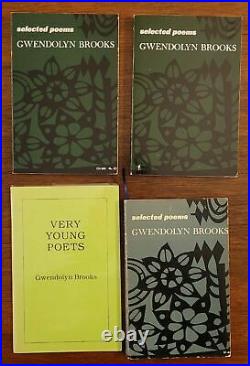
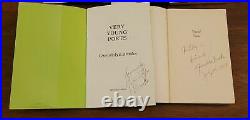
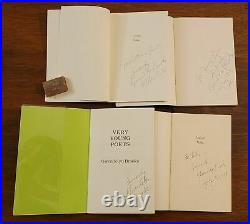
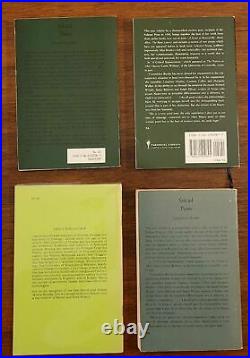
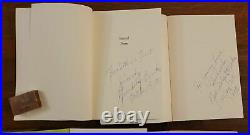

4 SIGNED BOOKS BY THE FIRST AFRICAN AMERICAN TO WIN A PULIZE PRIZE GWENDOLYN BROOKS. INSCRIBED BY GWNDOLYN BROOKS ON OCTOBER 18, 1983. INSCRIBED BY GWENDOLYN BROOKS ON MAY 25, 1992. SIGNED BY GWENDOLYN BROOKS. INSCRIBED BY GWENDOLYN BROOKS ON JULY 12, 1968. Gwendolyn Elizabeth Brooks was an American poet, author, and teacher. Her work often dealt with the personal celebrations and struggles of ordinary people in her community. She won the Pulitzer Prize for Poetry on May 1, 1950, for Annie Allen, making her the first African American to receive a Pulitzer Prize. Gwendolyn Brooks is one of the most highly regarded, influential, and widely read poets of 20th-century American poetry. She was a much-honored poet, even in her lifetime, with the distinction of being the first Black author to win the Pulitzer Prize. She also was poetry consultant to the Library of Congress-the first Black woman to hold that position-and poet laureate of the State of Illinois. Many of Brooks’s works display a political consciousness, especially those from the 1960s and later, with several of her poems reflecting the civil rights activism of that period. Her body of work gave her, according to critic George E. Kent, a unique position in American letters. Not only has she combined a strong commitment to racial identity and equality with a mastery of poetic techniques, but she has also managed to bridge the gap between the academic poets of her generation in the 1940s and the young Black militant writers of the 1960s. Brooks was born in Topeka, Kansas, but her family moved to Chicago when she was young. Her father was a janitor who had hoped to become a doctor; her mother was a schoolteacher and classically trained pianist. They were supportive of their daughter’s passion for reading and writing. Brooks was 13 when her first published poem, “Eventide, ” appeared in American Childhood; by the time she was 17 she was publishing poems frequently in the Chicago Defender, a newspaper serving Chicago’s African American population. After attending junior college and working for the National Association for the Advancement of Colored People, she developed her craft in poetry workshops and began writing the poems, focusing on urban Black experience, that comprised her first collection, A Street in Bronzeville (1945). Her poems in A Street in Bronzeville and the Pulitzer Prize-winning Annie Allen (1949) were “devoted to small, carefully cerebrated, terse portraits of the Black urban poor, ” commented Richard K. Barksdale in Modern Black Poets: A Collection of Critical Essays. Brooks once described her style as “folksy narrative, ” but she varied her forms, using free verse, sonnets, and other models. Several critics welcomed Brooks as a new voice in poetry; fellow poet Rolfe Humphries wrote in the New York Times Book Review that “we have, in A Street in Bronzeville, a good book and a real poet, ” while Saturday Review of Literature contributor Starr Nelson called that volume a work of art and a poignant social document. ” In Annie Allen, which follows the experiences of a Black girl as she grows into adulthood, Brooks married social issues, especially around gender, with experimentation: one section of the book is an epic poem, “The Anniad-a play on The Aeneid. Langston Hughes, in a review of Annie Allen for Voices, remarked that the people and poems in Gwendolyn Brooks’ book are alive, reaching, and very much of today. In the 1950s Brooks published her first and only novel, Maud Martha (1953), which details its title character’s life in short vignettes. Maud suffers prejudice not only from white people but also from lighter-skinned African Americans, something that mirrored Brooks’s experience. Eventually, Maud takes a stand for her own dignity by turning her back on a patronizing, racist store clerk. One way of looking at the book, then, commented Harry B. Shaw is as a war with. People’s concepts of beauty. ” In a Black World review, Annette Oliver Shands noted the way in which “Brooks does not specify traits, niceties or assets for members of the Black community to acquire in order to attain their just rights. So, this is not a novel to inspire social advancement on the part of fellow Blacks. Nor does it say be poor, Black and happy. The message is to accept the challenge of being human and to assert humanness with urgency. Brooks’s later work took on politics more overtly, displaying what National Observer contributor Bruce Cook termed an intense awareness of the problems of color and justice. ” Toni Cade Bambara reported in the New York Times Book Review that at the age of 50 “something happened to Brooks, a something most certainly in evidence in In the Mecca (1968) and subsequent works-a new movement and energy, intensity, richness, power of statement and a new stripped lean, compressed style. A change of style prompted by a change of mind. This shift or change is often depicted as the result of Brooks’s attendance at a gathering of Black writers at Fisk University in 1967; however, recent scholars such as Evie Shockley and Cheryl Clark challenge the idea that Brooks’s career can be so neatly divided. Clark, for example, has described In the Mecca as Brooks’s final seminar on the Western lyric. Brooks herself noted that the poets at Fisk were committed to writing as Blacks, about Blacks, and for a Black audience. If many of her earlier poems had fulfilled this aim, it was not due to conscious intent, she said; but from this time forward, Brooks thought of herself as an African determined not to compromise social comment for the sake of technical proficiency. Although In the Mecca and Brooks’s subsequent works have been characterized as possessing what a Virginia Quarterly Review critic called “raw power and roughness, ” several commentators emphasized that these poems are neither bitter nor vengeful. Instead, according to Cook, they are more “about bitterness” than bitter in themselves. Essayist Charles Israel suggested that In the Mecca’s title poem, for example, shows a deepening of Brooks’s concern with social problems. A mother has lost a small daughter in the block-long ghetto tenement, the Mecca; the long poem traces her steps through the building, revealing her neighbors to be indifferent or insulated by their own personal obsessions. The mother finds her little girl, who “never learned that black is not beloved, ” who “was royalty when poised, / sly, at the A and P’s fly-open door, ” under a Jamaican resident’s cot, murdered. Other poems in the book, occasioned by the death of Malcolm X or the dedication of a mural of Black heroes painted on a Chicago slum building, express Brooks’s commitment to her community’s awareness of themselves as a political as well as a cultural entity. Brooks’s activism and her interest in nurturing Black literature led her to leave major publisher Harper & Row in favor of fledgling Black publishing companies. In the 1970s, she chose Dudley Randall’s Broadside Press to publish her poetry collections Riot (1969), Family Pictures (1970), Aloneness (1971), Aurora (1972), and Beckonings (1975) and Report from Part One (1972), the first volume of her autobiography. She edited two collections of poetry-A Broadside Treasury (1971) and Jump Bad: A New Chicago Anthology (1971)-for the Detroit-area press. The Chicago-based Third World Press, run by Haki R. Lee, one of the young poets she had met during the 1960s-also brought many Brooks titles into print. Brooks was the first writer to read in Broadside’s original Poet’s Theatre series and was also the first poet to read in the second opening of the series when the press was revived under new ownership in 1988. Brooks, however, felt that Riot, Family Pictures, Beckonings, and other books brought out by Black publishers were given only brief notice by critics of the literary establishment because they did not wish to encourage Black publishers. Later Brooks poems continue to deal with political subjects and figures, such as South African activist Winnie Mandela, the onetime wife of antiapartheid leader-and later president of the country-Nelson Mandela. Brooks once told interviewer George Stavros: I want to write poems that will be non-compromising. I don’t want to stop a concern with words doing good jobs, which has always been a concern of mine, but I want to write poems that will be meaningful. Things that will touch them. Brooks’s work was objective about human nature, several reviewers observed. Janet Overmeyer noted in the Christian Science Monitor that Brooks’s particular, outstanding, genius is her unsentimental regard and respect for all human beings. She neither foolishly pities nor condemns-she creates. ” Overmeyer continued, “From her poet’s craft bursts a whole gallery of wholly alive persons, preening, squabbling, loving, weeping; many a novelist cannot do so well in ten times the space. ” Littlejohn maintained that Brooks achieves this effect through a high “degree of artistic control, ” further relating, “The words, lines, and arrangements have been worked and worked and worked again into poised exactness: the unexpected apt metaphor, the mock-colloquial asides amid jewelled phrases, the half-ironic repetitions-she knows it all. ” More important, Brooks’s objective treatment of issues such as poverty and racism “produces genuine emotional tension, the critic wrote. Among Brooks’s major prose works are her two volumes of autobiography. When Report from Part One was published, some reviewers expressed disappointment that it did not provide the level of personal detail or the insight into Black literature that they had expected. “They wanted a list of domestic spats, ” remarked Brooks. Bambara noted that it is not a sustained dramatic narrative for the nosey, being neither the confessions of a private woman poet or the usual sort of mahogany-desk memoir public personages inflict upon the populace at the first sign of a cardiac. It documents the growth of Gwen Brooks. Other critics praised the book for explaining the poet’s new orientation toward her racial heritage and her role as a poet. New consciousness and trudge-toward-progress. I know that the Black-and-white integration concept, which in the mind of some beaming early saint was a dainty spinning dream, has wound down to farce. I know that the Black emphasis must be not against white but FOR Black. In the Conference-That-Counts, whose date may be 1980 or 2080 (woe betide the Fabric of Man if it is 2080), there will be no looking up nor looking down. ” In the future, she envisioned “the profound and frequent shaking of hands, which in Africa is so important. The shaking of hands in warmth and strength and union. Brooks put some of the finishing touches on the second volume of her autobiography while serving as poetry consultant to the Library of Congress. Brooks was 68 when she became the first Black woman to be appointed to the post. Similar visits to colleges, universities, prisons, hospitals, and drug rehabilitation centers characterized her tenure as poet laureate of Illinois. In that role, she sponsored and hosted annual literary awards ceremonies at which she presented prizes funded “out of her own pocket, which, despite her modest means, is of legendary depth, ” Reginald Gibbons related in Chicago Tribune Books. She honored and encouraged many poets in her state through the Illinois Poets Laureate Awards and Significant Illinois Poets Awards programs. Proving the breadth of Brooks’s appeal, poets representing a wide variety of “races and. Poetic camps” gathered at the University of Chicago to celebrate the poet’s 70th birthday in 1987, Gibbons reported. Brooks brought them together, he said, in. A moment of good will and cheer. In recognition of her service and achievements, a junior high school in Harvey, Illinois, was named for her, and she was similarly honored by Western Illinois University’s Gwendolyn Brooks Center for African-American Literature. In 2017 celebrations of the centenary of Brooks’s birth were held at the University of Chicago and the University of Illinois, Champaign-Urbana, where Gwendolyn Brooks’s papers are held. Gwendolyn Elizabeth Brooks (June 7, 1917 – December 3, 2000) was an American poet, author, and teacher. She won the Pulitzer Prize for Poetry on May 1, 1950, for Annie Allen, [1] making her the first African American to receive a Pulitzer Prize. Throughout her prolific writing career, Brooks received many more honors. A lifelong resident of Chicago, she was appointed Poet Laureate of Illinois in 1968, a position she held until her death 32 years later. [4] She was also named the Poet Laureate Consultant in Poetry to the Library of Congress for the 1985-86 term. [5] In 1976, she became the first African-American woman inducted into the American Academy of Arts and Letters. Gwendolyn Elizabeth Brooks was born on June 7, 1917, in Topeka, Kansas. [2] She was the first child of David Anderson Brooks and Keziah (Wims) Brooks. Her father, a janitor for a music company, had hoped to pursue a career as a doctor but sacrificed that aspiration to get married and raise a family. Her mother was a school teacher as well as a concert pianist trained in classical music. Brooks’ mother had taught at the Topeka school that later became involved in the famous Brown v. Board of Education racial desegregation case. [7] Family lore held that Brooks’ paternal grandfather had escaped slavery to join the Union forces during the American Civil War. When Brooks was six weeks old, her family moved to Chicago during the Great Migration, and from then on, Chicago remained her home. She would closely identify with Chicago for the rest of her life. In a 1994 interview, she remarked. Living in the city, I wrote differently than I would have if I had been raised in Topeka, KS… Living there has given me a multiplicity of characters to aspire for. I hope to live there the rest of my days. That’s my headquarters. She started her formal education at Forestville Elementary School on Chicago’s South Side. [10] Brooks then attended a prestigious integrated high school in the city with a predominantly white student body, Hyde Park High School; transferred to the all-black Wendell Phillips High School; and finished her schooling at integrated Englewood High School. According to biographer Kenny Jackson Williams, due to the social dynamics of the various schools, in conjunction with the era in which she attended them, Brooks faced much racial injustice. Over time, this experience helped her understand the prejudice and bias in established systems and dominant institutions, not only in her own surroundings but in every relevant American mindset. Brooks began writing at an early age and her mother encouraged her, saying, You are going to be the lady Paul Laurence Dunbar. [12] During her teenage years, she began submitting poems to various publications. By the time she had graduated from high school in 1935, she was already a regular contributor to The Chicago Defender. After her early educational experiences, Brooks never pursued a four-year college degree because she knew she wanted to be a writer and considered it unnecessary. I’m just a writer who loves to write and will always write. [9] She graduated in 1936 from a two-year program at Wilson Junior College, now known as Kennedy-King College, and worked as a typist to support herself while she pursued her career. Song of Winnie’, Library Walk, New York City. Brooks published her first poem, “Eventide”, in a children’s magazine, American Childhood, when she was 13 years old. [6] By the age of 16, she had already written and published approximately 75 poems. At 17, she started submitting her work to “Lights and Shadows, ” the poetry column of the Chicago Defender, an African-American newspaper. Her poems, many published while she attended Wilson Junior College, ranged in style from traditional ballads and sonnets to poems using blues rhythms in free verse. In her early years, she received commendations on her poetic work and encouragement from James Weldon Johnson, Richard Wright and Langston Hughes. [13] James Weldon Johnson sent her the first critique of her poems when she was only sixteen years old. Her characters were often drawn from the inner city life that Brooks knew well. She said, I lived in a small second-floor apartment at the corner, and I could look first on one side and then the other. There was my material. By 1941, Brooks was taking part in poetry workshops. A particularly influential one was organized by Inez Cunningham Stark, an affluent white woman with a strong literary background. Stark offered writing workshops at the new South Side Community Art Center, which Brooks attended. [14] It was here she gained momentum in finding her voice and a deeper knowledge of the techniques of her predecessors. Renowned poet Langston Hughes stopped by the workshop and heard her read “The Ballad of Pearl May Lee”. [14] In 1944, she achieved a goal she had been pursuing through continued unsolicited submissions since she was 14 years old: two of her poems were published in Poetry magazine’s November issue. In the autobiographical information she provided to the magazine, she described her occupation as a “housewife”. Brooks’ published her first book of poetry, A Street in Bronzeville (1945), with Harper & Brothers, after a strong show of support to the publisher from author Richard Wright. He said to the editors who solicited his opinion on Brooks’ work. There is no self-pity here, not a striving for effects. She takes hold of reality as it is and renders it faithfully. She easily catches the pathos of petty destinies; the whimper of the wounded; the tiny accidents that plague the lives of the desperately poor, and the problem of color prejudice among Negroes. The book earned instant critical acclaim for its authentic and textured portraits of life in Bronzeville. Brooks later said it was a glowing review by Paul Engle in the Chicago Tribune that “initiated My Reputation”. [14] Engle stated that Brooks’ poems were no more “Negro poetry” than Robert Frost’s work was “white poetry”. Brooks received her first Guggenheim Fellowship in 1946 and was included as one of the “Ten Young Women of the Year” in Mademoiselle magazine. Brooks’ second book of poetry, Annie Allen (1949), focused on the life and experiences of a young Black girl growing into womanhood in the Bronzeville neighborhood of Chicago. The book was awarded the 1950 Pulitzer Prize for poetry, and was also awarded Poetry magazine’s Eunice Tietjens Prize. In 1953, Brooks published her first and only narrative book, a novella titled Maud Martha, which in a series of 34 vignettes follows the life of a black woman named Maud Martha Brown as she moves about life from childhood to adulthood. It tells the story of a woman with doubts about herself and where and how she fits into the world. Maud’s concern is not so much that she is inferior but that she is perceived as being ugly, states author Harry B. Shaw in his book Gwendolyn Brooks. [17] Maud suffers prejudice and discrimination not only from white individuals but also from black individuals who have lighter skin tones than hers, something that is a direct reference to Brooks’ personal experience. Eventually, Maud stands up for herself by turning her back on a patronizing and racist store clerk. About the triumph of the lowly, Shaw comments. [17] In contrast, literary scholar Mary Helen Washington emphasizes Brooks’s critique of racism and sexism, calling Maud Martha “a novel about bitterness, rage, self-hatred, and the silence that results from suppressed anger”. In 1967, the year of Langston Hughes’s death, Brooks attended the Second Black Writers’ Conference at Nashville’s Fisk University. Here, according to one version of events, she met activists and artists such as Imamu Amiri Baraka, Don L. Lee and others who exposed her to new black cultural nationalism. Recent studies argue that she had been involved in leftist politics in Chicago for many years and, under the pressures of McCarthyism, adopted a black nationalist posture as a means of distancing herself from her prior political connections. [19] Brooks’s experience at the conference inspired many of her subsequent literary activities. She taught creative writing to some of Chicago’s Blackstone Rangers, otherwise a violent criminal gang. In 1968, she published one of her most famous works, In the Mecca, a long poem about a mother’s search for her lost child in a Chicago apartment building. The poem was nominated for the National Book Award for poetry. Her autobiographical Report From Part One, including reminiscences, interviews, photographs and vignettes, came out in 1972, and Report From Part Two was published in 1995, when she was almost 80. Brooks said her first teaching experience was at the University of Chicago when she was invited by author Frank London Brown to teach a course in American literature. It was the beginning of her lifelong commitment to sharing poetry and teaching writing. [9] Brooks taught extensively around the country and held posts at Columbia College Chicago, Northeastern Illinois University, Chicago State University, Elmhurst College, Columbia University, and the City College of New York. The Rare Book & Manuscript Library of the University of Illinois acquired Brooks’s archives from her daughter Nora Blakely. [21] In addition, the Bancroft Library at UC Berkeley has a collection of her personal papers, especially from 1950 to 1989. In 1939, Brooks married Henry Lowington Blakely, Jr. Whom she met after joining Chicago’s NAACP Youth Council. [6] They had two children: Henry Lowington Blakely III, and Nora Brooks Blakely. [2] Brooks’ husband died in 1996. From mid-1961 to late 1964, Henry III served in the U. Marine Corps, first at Marine Corps Recruit Depot San Diego and then at Marine Corps Air Station Kaneohe Bay. During this time, Brooks mentored her son’s fiancée, Kathleen Hardiman, in writing poetry. Upon his return, Blakely and Hardiman married in 1965. [14] Brooks had so enjoyed the mentoring relationship that she began to engage more frequently in that role with the new generation of young black poets. Gwendolyn Brooks died at her Chicago home on December 3, 2000, aged 83. 1946, Guggenheim Fellow in Poetry. 1950, Pulitzer Prize in Poetry[2] Gwendolyn Brooks in 1950 became the first African-American to be given a Pulitzer Prize. It was awarded for the volume, Annie Allen, which chronicled in verse the life of an ordinary black girl growing up in the Bronzeville neighborhood on Chicago’s South Side. 1968, appointed Poet Laureate of Illinois, a position she held until her death in 2000[2]. 1969, Anisfield-Wolf Book Award[26]. 1973, Honorary consultant in American letters to the Library of Congress[27]. 1976, inducted into the American Academy of Arts and Letters[6]. 1976, the Shelley Memorial Award of the Poetry Society of America[28]. 1980, appointed to Presidential Commission on the National Agenda for the Eighties. 1981, Gwendolyn Brooks Junior High School in Harvey, Illinois dedicated in her honor. 1985, selected as the Consultant in Poetry to the Library of Congress, an honorary one-year term, known as the Poet Laureate of the United States[2]. 1988, inducted into the National Women’s Hall of Fame[29]. 1989, awarded the Robert Frost Medal for lifetime achievement by the Poetry Society of America[30]. 1994, chosen to present the National Endowment for the Humanities’ Jefferson Lecture. 1994, received the National Book Foundation’s Medal for Distinguished Contribution to American Letters[31]. 1995, presented with the National Medal of Arts[32]. 1997, awarded the Order of Lincoln, the highest honor granted by the State of Illinois. 1999, awarded the Academy of American Poets Fellowship for distinguished poetic achievement[34]. 1970: Gwendolyn Brooks Cultural Center, Western Illinois University, Macomb, Illinois[35]. 1990: Gwendolyn Brooks Center for Black Literature and Creative Writing, Chicago State University[36]. 1995: Gwendolyn Brooks Elementary School, Aurora, Illinois. 2001: Gwendolyn Brooks College Preparatory Academy, Chicago, Illinois[37]. 2002: 100 Greatest African Americans[38]. 2002: Gwendolyn Brooks Middle School, Oak Park, Illinois[39]. 2003: Gwendolyn Brooks Illinois State Library, Springfield, Illinois[40][41]. 2004: Hyacinth Park in Chicago was renamed Gwendolyn Brooks Park. 2010: Inducted into the Chicago Literary Hall of Fame. 2017: Various centennial events in Chicago marked what would have been her 100th birthday. The opening ceremony on February 2, 2017, at the Art Institute of Chicago featured readings and discussions of Brooks’ influence by Pulitzer Prize-winning poets Rita Dove, Yusef Komunyakaa, Gregory Pardlo, Tracy K. Smith, and Natasha Trethewey. 2018: On what would have been her 101st birthday, a statue of her, titled “Gwendolyn Brooks: The Oracle of Bronzeville”, was unveiled at Gwendolyn Brooks Park in Chicago. The Poetry Foundation lists these works among others. A Street in Bronzeville, Harper, 1945. Annie Allen, Harper, 1949. Maud Martha, Harper, 1953. Bronzeville Boys and Girls, Harper, 1956. The Bean Eaters, Harper, 1960. In the Mecca, Harper, 1968. For Illinois 1968: A Sesquicentennial Poem, Harper, 1968. Riot, Broadside Press, 1969. Family Pictures, Broadside Press, 1970. Aloneness, Broadside Press, 1971. Report from Part One: An Autobiography, Broadside Press, 1972. Black Love, Brooks Press, 1982. Mayor Harold Washington; and, Chicago, the I Will City, Brooks Press, 1983. The Near-Johannesburg Boy, and Other Poems, David Co. Winnie, Third World Press, 1988. Report from Part Two, Third World Press, 1996. In Montgomery, and Other Poems, Third World Press, 2003. Several collections of multiple works by Brooks were also published. Letters by Brooks, Atlanta University, Atlanta, Georgia. Typescript for Annie Allen, State University of New York at Buffalo[27]. Golden shovel, a poetic form inspired by Brooks’ work. List of African American firsts. List of Poets from the United States. Gwendolyn Brooks, who illuminated the black experience in America in poems that spanned most of the 20th century, winning the Pulitzer Prize in 1950, died yesterday at her home in Chicago.’I wrote about what I saw and heard in the street,” Ms.’I lived in a small second-floor apartment at the corner, and I could look first on one side and then the other. Brooks’s early poetry, Chicago’s vast black South Side is called Bronzeville. It was”A Street in Bronzeville,” her first poetry anthology, that attracted the attention of the literary establishment in 1945. The Bronzeville poems were recommended to the editors of Harper & Row by Richard Wright, who admired her ability to capture”the pathos of petty destinies, the whimper of the wounded, the tiny incidents that plague the lives of the desperately poor, and the problems of common prejudice. But it was more than Ms. Brooks’s ability to write about struggling black people, particularly black women. There was also her mastery of the language of poetry.’Miss Brooks has a command over both the colloquial and the more austere rhythms,” the critic Rolfe Humphries wrote in The New York Times Book Review about the poems in”A Street in Bronzeville.’ Calling her”a real poet,” Mr. Humphries said of her technique,”There is a range of form: quatrains, free verse, ballads, sonnets — all appropriately controlled. Brooks said that her reputation was bolstered by a review of”Bronzeville” in The Chicago Tribune by Paul Engle, a poet and founder of the Iowa Writers School. Engle maintained that her poems were no more”Negro poetry” than Robert Frost’s poetry was”white poetry. Among the poems in”Bronzeville’ was”the old-marrieds,” a portrait of an aging couple. But in the crowding darkness not a word did they say. Though the pretty-coated birds had piped so lightly all. And he had seen the lovers in the little side-streets. And she had heard the morning stories clogged with. The Fresh Prince of Belles-Lettres? Will Smith Has a Memoir. When Kilauea Erupted, a New Volcanic Playbook Was Written. What Do I Owe My Difficult Mother-in-Law? Continue reading the main story. It was quite a time for loving. But in the crowded darkness not a word did they say. In”A Street in Bronzeville” Ms. Brooks created such indelible figures as the old, alienated Matthew Cole, who could only smile at such memories as”say, thoughts of a little boy licorice-full/Without a nickel for Sunday School,” and Satin Legs Smith, awakening on a Sunday. He sheds, with his pajamas, shabby days. And his desertedness, his intricate fear, the. Postponed resentments and the prim precautions. In 1946 and 1947, Ms. Brooks was awarded a grant from the American Academy of Arts and Letters and received fellowships from the Guggenheim Foundation. In 1949, she published her second volume of verse,”Annie Allen,” a portrait of a Bronzeville girl as a daughter, a wife and a mother, experiencing loneliness, loss, death and poverty. The critics praised her use of an experimental form she called the sonnet-ballad.’Full of insight and wisdom and pity, technically dazzling,” Phyllis McGinley wrote in The Times Book Review.’Annie Allen” won Poetry magazine’s Eunice Tietjens Memorial Prize in 1949 and the following year, it was awarded the Pulitzer Prize; Ms. Brooks became the first black writer to receive the prize since it was established in 1917. She acknowledged that it transformed her life.’Sometimes,” she added with a smile,”I feel that my name is Gwendolyn Pulitzer Brooks. Brooks wrote a novel,”Maud Martha,” which received scant consideration when it was published in 1953.’Maud Martha” traced the life of a Bronzeville woman from childhood to maturity and motherhood through a series of 34 vignettes. The reader meets Maud as a lonely, overweight girl of 7, follows her through a dreamy adolescence and finally sees her as a young newlywed living”in a sad gray building in a cold white world,” married to a man numbed by his struggle with white society. Brooks’s novel was overshadowed by her achievements as a poet and invidiously compared with Richard Wright’s”Native Son” and Ralph Ellison’s”Invisible Man,” epic novels with clear-cut socio-political themes. In recent years, however,”Maud Martha” has had a rebirth, and it is now regarded in some critical circles as an important forerunner of prominent themes in the works of today’s female writers.’Bronzeville Boys and Girls,” a collection of children’s poetry, appeared in 1956, followed by two poetry collections,”The Bean Eaters” (1960) and”Selected Poems” (1963). Critics noticed that Ms. Brooks’s vision was expanding from considerations of the everyday experiences of Bronzeville to a wider world that included the murder of Emmett Till in Mississippi in 1955 and the racial tensions in Little Rock in 1957. They also noticed — and most applauded — a sharper colloquial style that was emerging in poems like”We Real Cool” from”The Bean Eaters”. By the early 1960’s, Ms. Brooks had reached a high point in her writing career. She was regarded as a grande dame of America’s black writers and an honored member of the literary elite, a sought-after teacher, a poet who was valued for her sensitive portraits of black women, her precise use of language and the universality of her work. But by the end of the decade she had transformed herself and her poetry — a reflection of the new political dynamics that were sweeping across all the Bronzevilles of America. Gwendolyn Elizabeth Brooks was born in Topeka, Kan. On June 7, 1917, but grew up on the South Side of Chicago, where she remained till she died. Her parents, David Anderson Brooks and the former Keziah Corinne Wims, encouraged her and her younger brother, Raymond, to read and take an interest in culture from an early age. Gwendolyn began writing poetry before she was a teenager, filling composition books with”careful rhymes” and”lofty meditations.’ Her mother was an enthusiastic supporter, often telling her,”You are going to be the lady Paul Laurence Dunbar. Brooks published her first poem,”Eventide,” in American Childhood when she was 13. Prompted by her mother, the teenager sent her poems to Langston Hughes and James Weldon Johnson. Hughes, who would become her friend and longtime supporter, wrote back:”You have talent. You’ll have a book published one day. Johnson also responded with encouragement, urging her to read such modern poets as Wallace Stevens, e. By the age of 16, Ms. Brooks had become a regular contributor to the”Lights and Shadows” column of The Chicago Defender, where many of her earliest poems appeared. Three years after her graduation from the newly opened Woodrow Wilson Junior College in Chicago in 1936, Ms. Brooks married Henry L. Blakely, a young writer who later published a volume of his own poetry. They lived in Chicago for the next 30 years, divorced in 1969 but reunited in 1973. Her survivors include a daughter, Nora Brooks Blakely, and a son, Henry Blakely. Brooks’s poetry shifted noticeably in form and concern after she attended a conference of black writers at Fisk University in the spring of 1967. While there she listened to readings by Amiri Baraka, Ron Milner and other young firebrand poets.’I felt that something new was happening,” she later said. Those young black writers”seemed so proud and committed to their own people,” she added.’The poets among them felt that black poets should write as blacks, about blacks, and address themselves to blacks. She later wrote:”If it hadn’t been for these young people, these young writers who influenced me, I wouldn’t know what I know about this society. Returning to Chicago, she began a poetry workshop in her home that included members of a Chicago street gang called the Blackstone Rangers and younger poets like Sonia Sanchez, Don L. Lee and Nikki Giovanni. Much of the talk was devoted to ways of merging the concept of black art with the political concept of black power. These currents were evident in Ms. Brooks’s next volume of poetry,”In the Mecca” (Harper 1968). The 30-page title poem described a mother’s frantic search for her missing daughter in a sprawling, decrepit building called the Mecca, which once was one of Chicago’s fanciest apartment houses. In a volume that was described by one critic as”her declaration of independence” from the integrationist pursuit that had previously shaped her work, Ms. Brooks wrote about the desperate and tragic lives of the inhabitants of the Mecca. She wrote from experience. Brooks worked at the real Mecca as a typist for a”spiritual adviser” when she was young and got to know the people in the building. The collection also offered poems about Malcolm X and the Blackstone Rangers. Sores in the city. That do not want to heal. Brooks used clipped lines, abstract word patterns and random rhymes to capture her new radical tone and her more direct expression of social concern.’In the Mecca” was nominated for a National Book Award. Asked if the change in work signaled her emergence as a”protest poet,” Ms. Brooks said,”No matter what the theme is, I still want the poem to be a poem, not just a piece of propaganda. Brooks reflected the change in her 1988 poem”Winnie”. Shape perfect unimportant pieces. Poems that cough lightly — catch a sneeze. This is the time for Big Poems. Roaring up out of the sleaze. Poems from ice, from vomit, and from tainted blood. After the publication of”In the Mecca” Ms. Brooks left her longtime mainstream publisher, Harper & Row.’Rio” (1969), her next volume of poetry, was published by Broadside Press, a small, Detroit-based black company. The change, she said, reflected her desire to support struggling black publishers and the young poets they published as well as her intention to address her work to black readers. With the new direction of her work and the lack of a major mainstream publisher, however, many of her subsequent books were brushed aside by reviewers for mainstream publications. From the 1970’s to the 1990’s, she published more than a dozen volumes of poetry and nearly a dozen nonfiction titles, which included two autobiographical works –”Report From Part One” (1972) and”Report From Part Two” (1995). Despite the lack of media attention, Ms. Brooks maintained her reputation as one of America’s most respected literary figures. In 1968, she succeeded Carl Sandburg as poet laureate of Illinois. In 1976, she became the first black woman to be elected to the 250-member National Institute of Arts and Letters. She received a lifetime achievement award from the National Endowment for the Arts in 1989 and another from the National Book Foundation in 1994. She was the recipient of more than 50 honorary degrees. The Gwendolyn Brooks Chair in Black Literature and Creative Writing was established at Chicago State University in 1990, and there is a Gwendolyn Brooks Center for African-American Literature at Western Illinois University and a Gwendolyn Brooks Junior High School just south of Chicago in Harvey, Ill. She was selected by the National Endowment of the Humanities as its Jefferson Lecturer in 1994 –”the absolute award crown of my career,” she said. And in 1995 she received the National Medal of Arts award. Despite such praise, Ms. Brooks preferred to stay outside what she called”the hollow land of fame” and quietly live and work on the South Side.’All my life is not writing,” Ms. Brooks once told an interviewer.’My greatest interest is being involved with young people.’ To that end, she devoted much time to giving readings at schools, prisons and hospitals and attending annual poetry contests for school-age youngsters, which she sponsored, judged, and often paid for out of her own pocket. During her later years, Ms. Brooks tempered her assessment of the young poets of the 60’s who had criticized her subjectivity and attention to form.’Many of the poets felt it was a mark of their quality, of their black and Hispanic quality, if they didn’t put a lot of emphasis on technique,” she said. Although she still sought to write poetry that was”direct” and appealed to”all manner of blacks,” she insisted on maintaining her own standards.’I don’t want to imitate these young people,” she said.’I have got to find a way of writing that will accomplish my purpose but still sound Gwendolynian. A Gwendolyn Brooks Sampler.’the vacant lot,” from”A Street in Bronzeville” (1945). Corley’s three-flat brick. Isn’t here any more. All done with seeing her fat little form. Burst out of the basement door. And with seeing her African son-in-law. (Rightful heir to the throne). With his great white strong cold squares of teeth. And his little eyes of stone. And with seeing the squat fat daughter. Letting in the men. When majesty has gone for the day. And letting them out again.’The Egg Boiler,” from”The Bean Eaters” (1961). Being you, you cut your poetry from wood. The boiling of an egg is heavy art. You come upon it as an artist should. With rich-eyed passion and with straining heart. We fools, we cut our poems out of air. Night color, wind soprano, and such stuff. And sometimes weightlessness is much to bear. You mock it, though, you name it Not Enough. The egg, spooned gently to the avid pan. And left the strict three minutes, or the four. Is your Enough and art for any man. We fools give courteous ear — then cut some more. Shaping a gorgeous Nothingness from the cloud. You watch us, eat your egg, and laugh aloud. In 1944 an editor at Harper & Brothers contacted Richard Wright, the author of Native Son, to ask his opinion of poems submitted for publication by a Chicago woman named Gwendolyn Brooks. They are hard and real, right out of the central core of Black Belt Negro life in urban areas. There is no self-pity here, not a striving for effect. There is not so much an exhibiting of Negro life to whites in these poems as there is an honest human reaction to the pain that lurks so colorfully in the Black Belt. She easily catches the pathos of petty destinies; the whimper of the wounded; the tiny incidents that plague the lives of the desperately poor, and the problem of color prejudice among Negroes. Only one who has actually lived and suffered in a kitchenette could render the feeling of lonely frustration as well as she does: – of how dreams are drowned out by the noises, smells, and the frantic desire to grab one’s chance to get a bath when the bathroom is empty. Miss Brooks is real and so are her poems. Brooks reads’Kitchenette Building. In 1950, the year Gwendolyn Brooks became the first African-American to win the Pulitzer Prize, her editor asked her what made her write. Brooks answered that she wrote to prove to others (by implication, not by shouting) and to such among themselves who have yet to discover it, that they are merely human beings, not exotics. ” She wrote while “scrubbing, washing, ironing, cooking: dropping the mop, broom, soap, iron or carrot grater to write down a line, or word. When the galleys of Annie Allen were ready, the editor, Elizabeth Lawrence, sent them to Wright, Langston Hughes and Alfred Kreymborg, a poet, anthologist and chess master who had long been a figure in the New York literary scene. His critique: Though this volume weighs little in the hand, it weighs much in the heart and the mind. The jury that year faced some challenges. William Carlos Williams, long a friend and colleague of Kreymborg’s, had published both a Selected Poems and the first parts of Paterson in 1949. He was in his mid-60s and had never won a Pulitzer Prize. Robert Frost’s Complete Poems came out that year as well. He was 75 and had won the prize four times. His friend, Louis Untermeyer, was on the jury with Kreymborg. The third member, serving on the Poetry jury for the eighth consecutive year, was Henry Seidel Canby, a noted English professor at Yale. Canby described in his letter to the dean of Columbia’s Graduate School of Journalism how the three men had arrived at their choice. Here is the letter. A volume of great originality, real distinction and high value. Graduate School of Journalism. New York 27, N. I have the honor to submit herewith the recommendations of the Advisory Committee, consisting of myself, Louis Untermeyer, and Alfred Kreymborg, for the Pulitzer Prize in Poetry this year. Frost’s Complete Poems. The finest book of poetry this year is very naturally the Complete Poems of Robert Frost, which summarizes his whole career. For various good reasons, the Committee feels it would be most unwise to give the award to this book, unless no other worthy candidate was in sight. I quote the statement of Mr. Untermeyer, with which I entirely agree, that a fifth award to Mr. Frost would actually be a double or triple or quadruple award to a body of poems already so distinguished, for these are in all probability much his finest poems. If the judges were to award the prize literally to the best book of the year, the prize would have to be given to the Complete Poems of Robert Frost. As the title indicates, this is the cumulative work of the greatest living American poet, possibly the greatest poet living today. But – and it is an important “but” – Frost has received the award four times… And, with the exception of a few added titles, for the same poems! A further’honor’ to Frost would be not only superfluous but so repetitious as to seem silly. In addition, an award to Frost would be a confession that current poetry is so lifeless that we have to turn again to the one poet we can cite as a contemporary tradition. There is another important contribution to poetry this year which also deserves a special statement. William Carlos Williams has been steadily growing in stature and published in 1949 a book of Selected Poems and the first three sections of his long poem called Paterson. A number of Mr. Williams’s briefer poems have already taken their places in anthologies, but he lacks self-criticism, and his total output so far is frequently distinguished by an extreme of obscurity. This is especially true of his long poem. There is every reason to believe that his new Selected Poems, to be published in 1950, will be much more representative of what he can do, and less full of failures. Also, it is at least possible that the fourth section of his Paterson, also to be published this year, may throw some light, at present absent, on the significance of the whole. We do not feel inclined to recommend him for a Pulitzer Prize this year. We believe that next year it will be possible to form a much sounder judgment, either positive or negative. Brooks with a copy of A Street in Bronzeville. Fortunately, among the other books of poems submitted for an award is a volume of great originality, real distinction and high value as a book, as well as poetry. Some years ago, Gwendolyn Brooks, a Negro writer of unusual ability, published A Street in Bronzeville, which made a great impression on all its readers and had what is unusual for poetry today – a wide sale. In 1949 she published Annie Allen, a much better book, and indeed, in our opinion, the outstanding volume of the year, if you exclude Robert Frost. No other Negro poet has written such poetry of her own race, of her own experiences, subjective and objective, and with no grievance or racial criticism as the purpose of her poetry. It is highly skillful and strong poetry, out of the heart, but rich with racial experience. I quote from Mr. Alfred Kreymborg, with whose opinion I entirely agree. A few years ago, Gwendolyn Brooks, the young Chicago poet, made her debut in book form with A Street in Bronzeville, a small Spoon River Anthology of the Negro. This was followed last year by Annie Allen, an even finer volume, which introduces further characters out of her South Side background, with Annie herself as the central figure with her peregrinations from childhood through girlhood to womanhood. These Notes, as the author modestly calls her varied lyrics and ballads, are finally developed in a single short narrative, The Anniad, whose title deftly parodies The Aeneid and whose intellectual sweep over common experience is not only brilliant but profound in its tragic and tragicomic implications. The book as a whole gives evidence that the poet firmly resisted temptations of special pleading, the bane of most social verse in our time. Her work is truly objective, never propagandistic, and above all original. Gwendolyn Brooks has twice received Guggenheim Fellowships and a Grant from the American Academy of Arts and Letters. In recommending that she receive the 1949 Award for Poetry from the Pulitzer Committee, for which the judges voted unanimously, they feel that a wider public will be drawn toward an artist of outstanding merit. There are, as is usually the case in a Pulitzer contest, a group of seven books, all of them of high competence, and all deserving great praise. These are the following. An Acre in the Seed (posthumous), Theodore Spencer. Live Another Day, John Ciardi. Aspects of Proteus, Hyam Plutzik. Volume II, Jose Garcia Villa. Walk Through Two Landscapes, Dilys Bennett Laing. The Tears of the Blind Lions, Thomas Merton. There are potential takers of the Pulitzer Prize in the future in this group, but the Committee unanimously does not wish to recommend this year any one of them. I may say that we have seldom been more satisfied than with our choice of Annie Allen. In 1950, Gwendolyn Brooks became the first African-American to be awarded a Pulitzer Prize. Hers was a Pulitzer in poetry, specifically for a volume titled Annie Allen that chronicled the life of an ordinary black girl growing up in the Bronzeville neighborhood on Chicago’s famous South Side. Brooks was in her living room when she learned she had won, she recalled in a Library of Congress interview, and it was growing dark. She didn’t turn on the lights, because she knew what would happen. She also knew that her Pulitzer made her something of a unicorn, and began to worry about what was going to happen when word got out. “The next day, reporters came, photographers came, ” she recalled. And I was absolutely petrified. I wasn’t going to say anything about the electricity. But I knew when they went to plug in their cameras and all, nothing was going to happen. They plugged in their lights. The living room was sufficiently illuminated. Someone – “I never did find out who” – had quietly paid the bill. The universe had made sure that Gwendolyn Brooks, so generous to others, was taken care of. In a way, it was life imitating art imitating life: she mostly wrote about everyday people with everyday problems, in language that varied from the classic to the colloquial. Gwendolyn Brooks Captures Chicago’Cool. Brown girl in Bronzeville. Gwendolyn Elizabeth Brooks was born on June 7, 1917, in Topeka, Kan. But she moved to Chicago with her parents, Keziah and David, when she was 5 weeks old. The Brooks family joined thousands of black families that were streaming into the city’s South Side, part of the Great Migration that would transform many large American cities north of the Mason-Dixon Line. Segregation confined the new arrivals to the South Side, where they created parallel institutions to the white ones that excluded them. Young Gwen came from a family of readers and book lovers, and announced early on that she intended to become a poet. Her mother encouraged her, and helped Gwen send her poems to magazines and to the Chicago Defender, the legendary black newspaper whose anti-lynching editorials were known in black communities throughout the country. In the 1930s, she received encouragement from the great James Weldon Johnson, and from Harlem Renaissance icons Langston Hughes and Richard Wright. Poet and biographer Angela Jackson says Brooks was published regularly in the Defender for several years, but the Pulitzer gave her a whole new kind of fame. A Surprised Queenhood in the New Black Sun. The Life & Legacy of Gwendolyn Brooks. “The fact that she was the first African-American to be awarded the Pulitzer made her notoriety go through the roof, ” Jackson said. “Kindness was her religion”. The award, and the financial reward that accompanies it, came at a time when Brooks and her husband, Henry Blakely, had a young son, Hank. Soon after, baby sister Nora arrived. Mothering took up a fair amount of time, but when the children were a bit older, Brooks continued giving readings, and she also began to teach. Nora Brooks Blakely remembers when her mother taught at three colleges concurrently: That Christmas, suddenly the Christmas presents changed… She just had a happy little fit, where she only got presents from Marshall Field’s and C. Brooks loved being able to do nice things for other people, even though she did not live a lavish lifestyle herself. It also took the pressure off people who were trying to write. “There were people she gave rent to, gave car payments to, ” Blakely remembers. “Kindness was her religion, ” says Haki Madhubuti, director of Third World Press, in Chicago. Madhubuti met Brooks in the early’60s, when he was a young veteran writing poetry in Chicago. He’d read her in anthologies while he was in the service. Like so many young poets at the time, I was in awe of her, her craft and her commitment to the black community. In his early career, Madhubuti was published under his birth name, Don L. But as a key member of the Black Arts movement – a contingent of artists, playwrights, poets and writers whose work reflected the cultural side of the growing Black Power movement – he chose a name that reflected his African heritage. He and Brooks grew as close as family – she often referred to him as her other son. She would later say he drew her into this new cultural circle and she felt reborn. Her poetry became more urgent, more pointed. She, in turn, was celebrated by what she fondly called “the riotous young people” who gathered at her home for long, often passionate discussions about black life, politics and culture. Black cultural celebrities of all sorts came by to visit the Blakelys: They held a party for Langston Hughes that was standing-room only. It was less throw-down, more salon: Ideas were exchanged and vigorously debated over food and drink. “I remember James Baldwin coming through the front door, ” Nora Blakely says. She remembers Baldwin’s large, piercing eyes, I panicked! I was just a little kid, and his eyes looked so big and commanding to me. When she taught, Brooks took the summers off, and would retreat into her home to enjoy reading and watching soap operas, rarely venturing out until summer’s end. Nora Blakely remembers that after she received her driver’s license, her mother sent her off to the grocery store. “Some of her grocery lists were poetry in themselves, ” she laughs. She would describe things like’bright, pearlescent, ruby tomatoes’ and so forth, to be very clear about what we were supposed to find. Those grocery lists are included in Brooks’ archives, at the University of Illinois. Brooks also began to travel during those summers off from teaching. She visited Kenya and Tanzania, and enjoyed making contacts on the African continent. Later, she and Henry would journey to Ghana. “She was making global connections between what was happening beside her and what was going on across the world, ” says biographer Angela Jackson. This enhanced consciousness was reflected not only in Brooks’ poetry, but in her person. “One day we walked in, ” Madhubuti remembers, and she had a scarf on her hair… Then she took the scarf off her head and she had a natural. She had a natural hairdo. Brooks was no longer interested in the tyranny of the straightening comb. She even wrote a poem about it. “To Those of My Sisters Who Kept Their Naturals” celebrates “the rich rouch right time of your hair, ” despite a country whose aesthetic seeks to coerce kinks. By the time Gwendolyn Brooks died, in 2000, she’d been showered with prizes and prestigious appointments. She’d been appointed poet laureate of the state of Illinois, a position she held for several years. In that role, she became a circuit rider for poetry, crisscrossing the state, visiting schools, prisons and hospitals, reading her poems and listening to others recite them. “We Real Cool” was a perennial favorite. She was the recipient of more than 70 honorary degrees from colleges around the country. She also served as a poetry consultant to the Library of Congress – the position that would eventually be renamed poet laureate of the United States. A writer’s conference was established in her name at Chicago State University. One year, Toni Morrison was the speaker, and the author told the audience she probably couldn’t have done what she did without Gwendolyn Brooks’ example and work to show her it was possible. Despite all the accolades and literary fame, “She was very unassuming, very humble, ” says fellow poet and friend Haki Madhubuti. “Her truth-telling was relentless, ” says Angela Jackson. But she didn’t sacrifice her craft to tell those truths. She insisted upon an elegance of speech, an elegance of writing – a heightened language that pierced through to people to engage the souls of readers. This item is in the category “Books & Magazines\Antiquarian & Collectible”. The seller is “memorabilia111″ and is located in this country: US. This item can be shipped to United States, Canada, United Kingdom, Denmark, Romania, Slovakia, Bulgaria, Czech Republic, Finland, Hungary, Latvia, Lithuania, Malta, Estonia, Australia, Greece, Portugal, Cyprus, Slovenia, Japan, China, Sweden, Korea, South, Indonesia, Taiwan, South Africa, Thailand, Belgium, France, Hong Kong, Ireland, Netherlands, Poland, Spain, Italy, Germany, Austria, Bahamas, Israel, Mexico, New Zealand, Singapore, Switzerland, Norway, Saudi Arabia, United Arab Emirates, Qatar, Kuwait, Bahrain, Croatia, Republic of, Malaysia, Brazil, Chile, Colombia, Costa Rica, Panama, Trinidad and Tobago, Guatemala, Honduras, Jamaica, Barbados, Bangladesh, Bermuda, Brunei Darussalam, Bolivia, Ecuador, Egypt, French Guiana, Guernsey, Gibraltar, Guadeloupe, Iceland, Jersey, Jordan, Cambodia, Cayman Islands, Liechtenstein, Sri Lanka, Luxembourg, Monaco, Macau, Martinique, Maldives, Nicaragua, Oman, Peru, Pakistan, Paraguay, Reunion, Vietnam, Uruguay.
- Topic: Literature
- Author: GWENDOLYN BROOKS
- Language: English
- Special Attributes: Inscribed

New Release Day 20 21 Sp Authentic 3 Auto S Pulled
Assassinorum Kingmaker Audiofish Audiobook
Shaun Alexander 2000 Upper Deck Encore Auto RC ROOKIE INSCRIBED Authent Pop 1/1




Extremely rare This has have to be his best card, Shaun Alexander 2000 Upper Deck Encore Auto RC INSCRIPTED PSA Authentic. ONLY ONE IN REGISTRY! This item is in the category “Sports Mem, Cards & Fan Shop\Sports Trading Cards\Trading Card Singles”. The seller is “computerman5523″ and is located in this country: US. This item can be shipped to United States.
- Autographed: Yes
- Set: 2000 Upper Deck Encore
- Autograph Format: Hard Signed
- Certification Number: 44187989
- Product: Single
- Player/Athlete: Shaun Alexander
- Card Thickness: 20 Point
- Graded: Yes
- Sport: Football
- Original/Reprint: Original
- Manufacturer: Upper Deck
- Features: Rookie
- Team: Seattle Seahawks
- Season: 2000
- League: NFL
- Player: Shaun Alexander
- Grade: Authentic
- Modified Item: Yes
- Card Attributes: Autograph, Rookie
- Series: Upper Deck Encore
- Type: Sports Trading Card
- Year: 2000
- Era: Modern (1970-Now)
- Theme: Sport
- Professional Grader: Professional Sports (PSA)
- Country/Region of Manufacture: United States
- Card Manufacturer: Upper Deck

Signed Inscribed John Fischetti Chicago Daily News Political Cartoon LBJ Vietnam
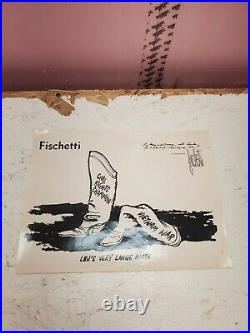
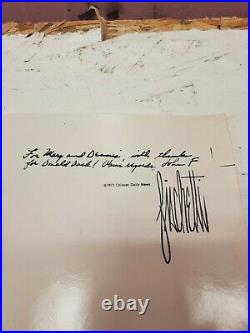
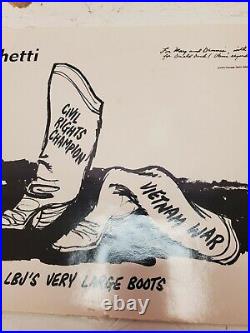

Signed Inscribed John Fischetti Chicago Daily News Political Cartoon LBJ Vietnam War Print 1973 13.5×10 (dd) (c111). This item is in the category “Collectibles\Autographs\Other Collectible Autographs”. The seller is “themerchant213″ and is located in this country: US. This item can be shipped to United States, Canada, United Kingdom, Denmark, Romania, Slovakia, Bulgaria, Czech Republic, Finland, Hungary, Latvia, Lithuania, Malta, Estonia, Australia, Greece, Portugal, Cyprus, Slovenia, Japan, China, Sweden, Korea, South, Indonesia, Taiwan, South Africa, Thailand, Belgium, France, Hong Kong, Ireland, Netherlands, Poland, Spain, Italy, Germany, Austria, Bahamas, Israel, Mexico, New Zealand, Philippines, Singapore, Switzerland, Norway, Saudi Arabia, United Arab Emirates, Qatar, Kuwait, Bahrain, Croatia, Republic of, Malaysia, Brazil, Chile, Colombia, Costa Rica, Panama, Trinidad and Tobago, Guatemala, Honduras, Jamaica, Antigua and Barbuda, Aruba, Belize, Dominica, Grenada, Saint Kitts-Nevis, Saint Lucia, Montserrat, Turks and Caicos Islands, Barbados, Bangladesh, Bermuda, Brunei Darussalam, Bolivia, Ecuador, Egypt, French Guiana, Guernsey, Gibraltar, Guadeloupe, Iceland, Jersey, Jordan, Cambodia, Cayman Islands, Liechtenstein, Sri Lanka, Luxembourg, Monaco, Macau, Martinique, Maldives, Nicaragua, Oman, Peru, Pakistan, Paraguay, Reunion, Vietnam, Uruguay.
- Country/Region of Manufacture: Vietnam

Dwayne The Rock Johnson Signed Book The Rock Says Wwf (wwe) Autographed






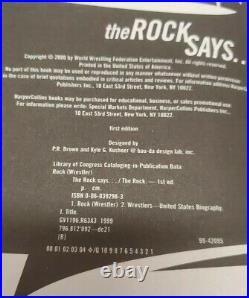




DWAYNE THE ROCK JOHNSON SIGNED BOOK – “THE ROCK SAYS” WWF (WWE) AUTOGRAPHED. Note that all items that are seen in listed photos are what will be sent upon placing order, please also note that the condition is listed, but view photos for verification of products condition. Upward Bound Books Team. This item is in the category “Books & Magazines\Books”. The seller is “upwardboundbooks” and is located in this country: US. This item can be shipped to United States, Canada, United Kingdom, Denmark, Romania, Slovakia, Bulgaria, Czech Republic, Finland, Hungary, Latvia, Lithuania, Malta, Estonia, Australia, Greece, Portugal, Cyprus, Slovenia, Japan, China, Sweden, Korea, South, Indonesia, Taiwan, South Africa, Thailand, Belgium, France, Hong Kong, Ireland, Netherlands, Poland, Spain, Italy, Germany, Austria, Bahamas, Israel, Mexico, New Zealand, Philippines, Singapore, Switzerland, Norway, Saudi Arabia, United Arab Emirates, Qatar, Kuwait, Bahrain, Croatia, Republic of, Malaysia, Chile, Colombia, Costa Rica, Panama, Trinidad and Tobago, Guatemala, Honduras, Jamaica, Antigua and Barbuda, Aruba, Belize, Dominica, Grenada, Saint Kitts-Nevis, Saint Lucia, Montserrat, Turks and Caicos Islands, Barbados, Bangladesh, Bermuda, Brunei Darussalam, Bolivia, Egypt, French Guiana, Guernsey, Gibraltar, Guadeloupe, Iceland, Jersey, Jordan, Cambodia, Cayman Islands, Liechtenstein, Sri Lanka, Luxembourg, Monaco, Macau, Martinique, Maldives, Nicaragua, Oman, Pakistan, Paraguay, Reunion, Uruguay.
- Personalize: Yes
- Type: Novel
- Signed By: The Rock
- Era: 2000s
- Signed: Yes
- Narrative Type: Nonfiction
- Country/Region of Manufacture: United States
- Inscribed: Yes
- Intended Audience: Young Adults, Adults
- Subject: Books on Collecting
- Personalization Instructions: signed by DWAYNE THE ROCK JOHNSON
- Vintage: No
- ISBN: 9780060392987
- Book Title: Rock Says
- Item Length: 9.1in.
- Publisher: HarperCollins
- Publication Year: 2000
- Format: Hardcover
- Language: English
- Item Height: 1.1in.
- Author: WWF, The the Rock
- Genre: Biography & Autobiography, Sports & Recreation
- Topic: Wrestling, Sports
- Item Width: 6.1in.
- Item Weight: 24.9 Oz
- Number of Pages: 304 Pages

Ken Griffey Jr. Signed 1989 Topps Traded #41T RC Inscribed HOF 16 (PSA) GEM MT





Rare hall of fame 16 card! This item is in the category “Sports Mem, Cards & Fan Shop\Sports Trading Cards\Trading Card Singles”. The seller is “bradyleelewisbrady” and is located in this country: US. This item can be shipped to United States.
- Card Size: Standard
- Autographed: Yes
- Set: 1989 Topps Traded
- Signed By: Ken Griffey Jr
- Autograph Format: Hard Signed
- Product: Single
- Player/Athlete: Ken Griffey Jr
- Year Manufactured: 1989
- Vintage: Yes
- Graded: Yes
- Sport: Baseball
- Language: English
- Autograph Authentication: Professional Sports Authenticator (PSA)
- Original/Reprint: Original
- Manufacturer: Topps
- Features: Rookie
- Team: Seattle Mariners
- Season: 1989
- League: Major League
- Card Condition: Mint
- Grade: 10
- Series: Topps
- Type: Sports Trading Card
- Theme: Sport
- Professional Grader: Professional Sports Authenticator (PSA)
- Card Number: 41
- Country/Region of Manufacture: United States
- Card Manufacturer: Topps

